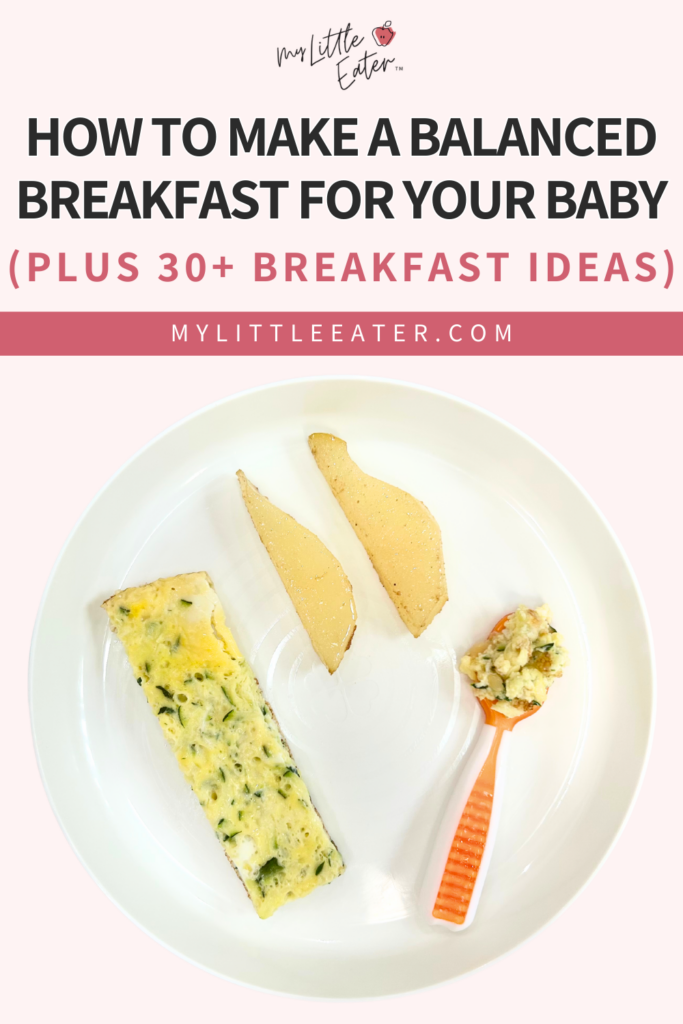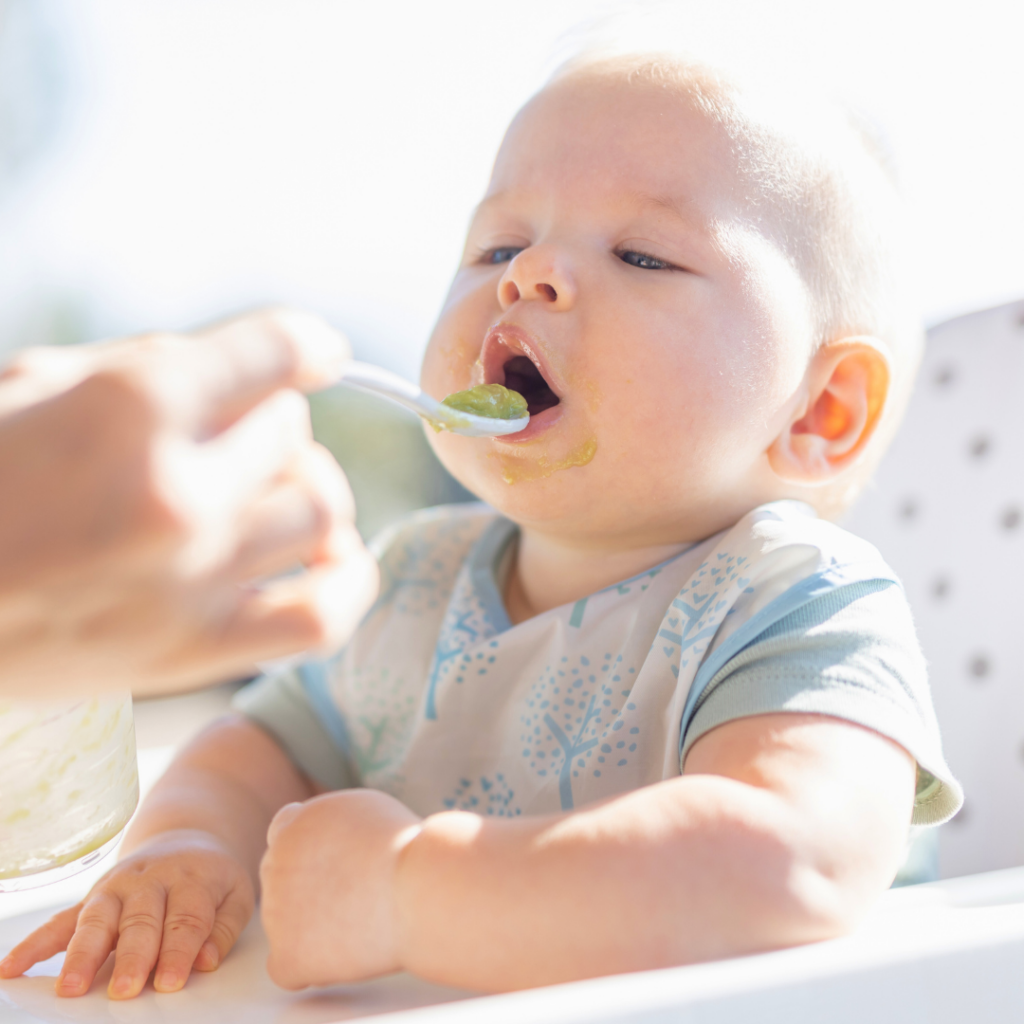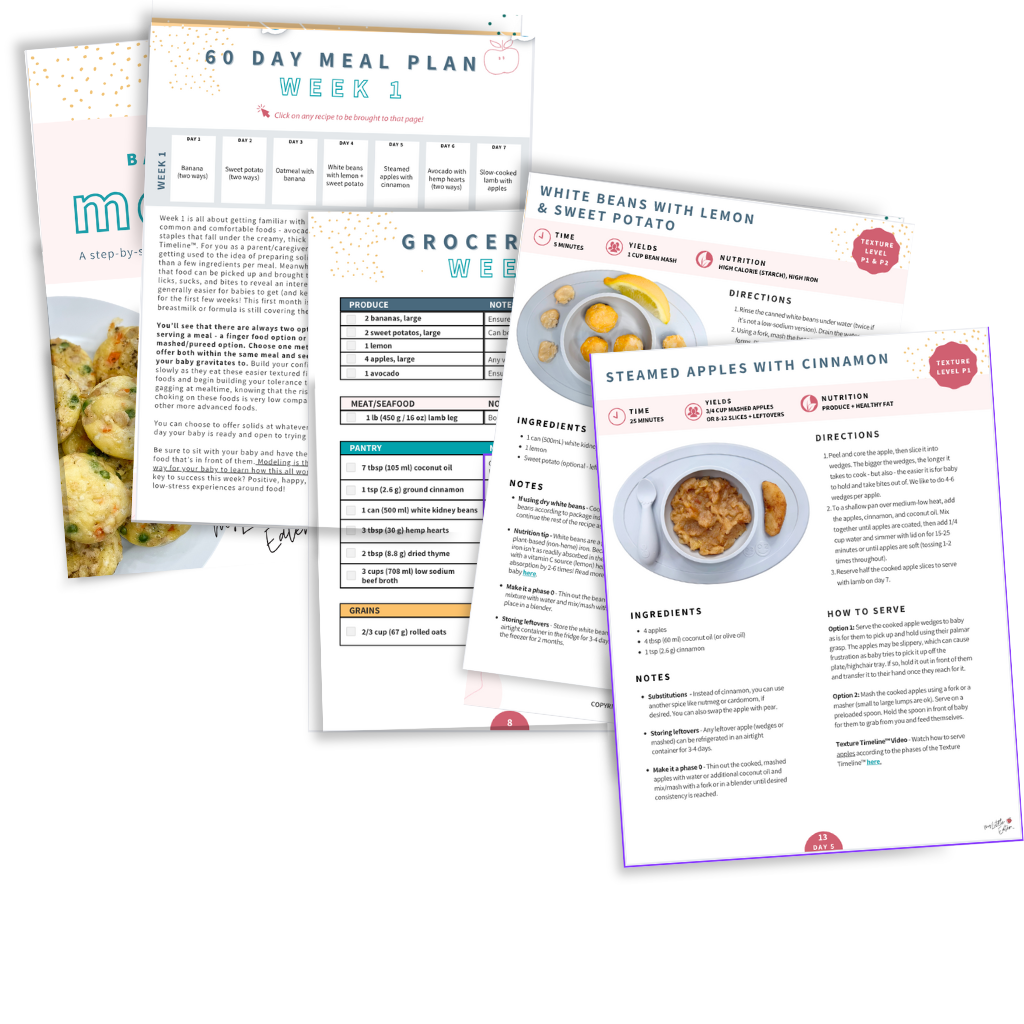This post may contain affiliate links, please view our disclosure policy for more details.
Ahh, breakfast…some people love it, some people skip it and some even call it the most important meal of the day. No matter how you feel about it, the fact is that breakfast is an important meal for babies and is an excellent time to introduce new foods and textures!
That being said, we know how easy it is to fall into a rut of offering the same foods for breakfast over and over again. If you’re tired of offering your baby the same breakfast day after day but don’t know what to offer instead, we’re here to help!
We’re going to go over what to feed your baby for breakfast and why, arm you with 30+ new breakfast ideas, and share a quick and easy breakfast recipe great for babies and adults alike – scrambled pancakes!
If you want to take the stress out of deciding what meals to serve, and how to safely serve them to your baby, you’ll love our 60-Day Baby Led Feeding Meal Plan!
You can feel confident knowing that your baby is getting the exposure to new foods and textures they need to prevent picky eating – with no extra planning or time wasted for you!
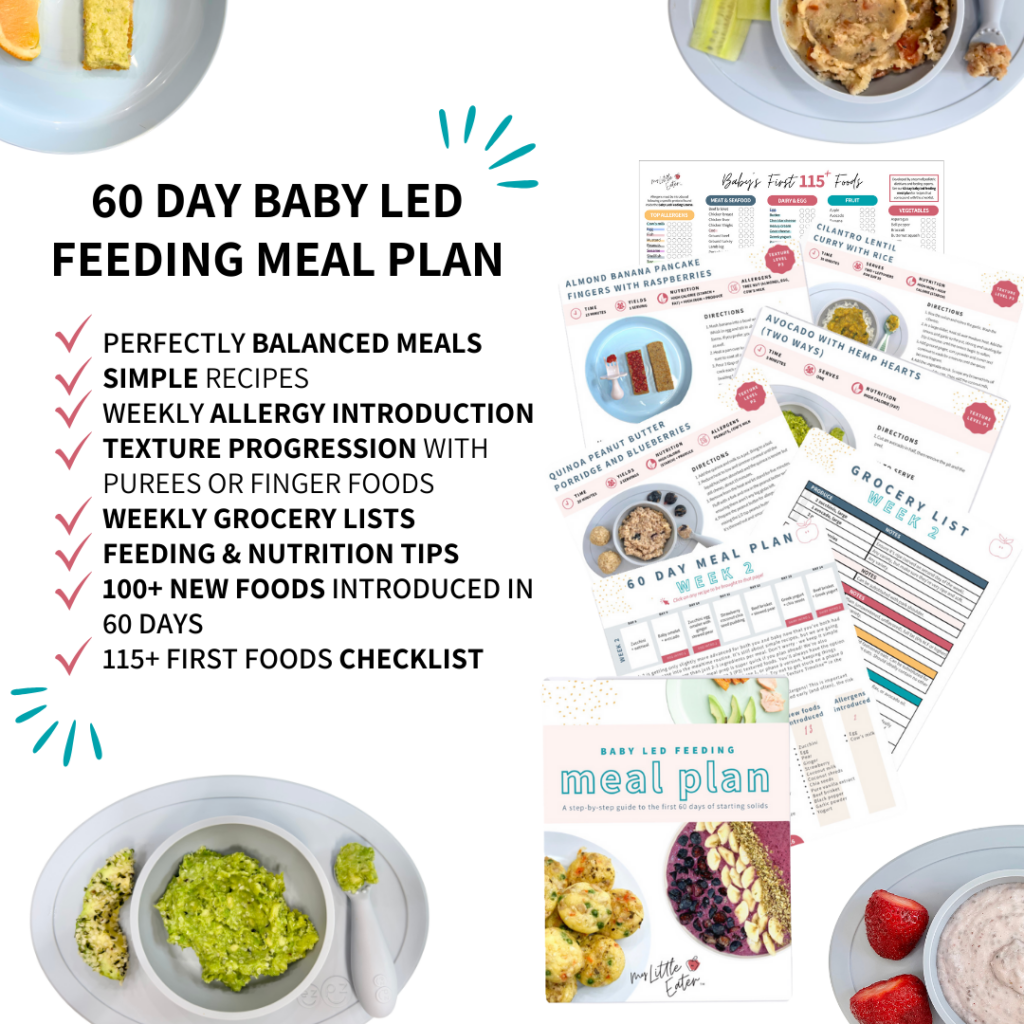
Table of Contents
30+ baby breakfast ideas
Eggs and toast are good breakfast food options…but they’re not the only options! So let’s get right to the good stuff – here are 30+ balanced breakfast ideas that your baby will love and that will keep your whole family out of a breakfast food rut!
Banana peanut butter oatmeal fingers with raspberries
If the usual bowl of oatmeal is getting a bit played out, oatmeal fingers can be a fun new way to serve oats to your baby! You only need quick oats, banana, peanut butter, milk, and a microwave to quickly throw these together.
Mix all ingredients, then press the mixture into a small square or rectangular microwave-safe dish. Microwave on high for 2-3 minutes until firm, then cut into finger-like shapes so that your baby can hold the oatmeal fingers using their palmar grasp. Serve oatmeal fingers alongside fruit, like flattened raspberries.
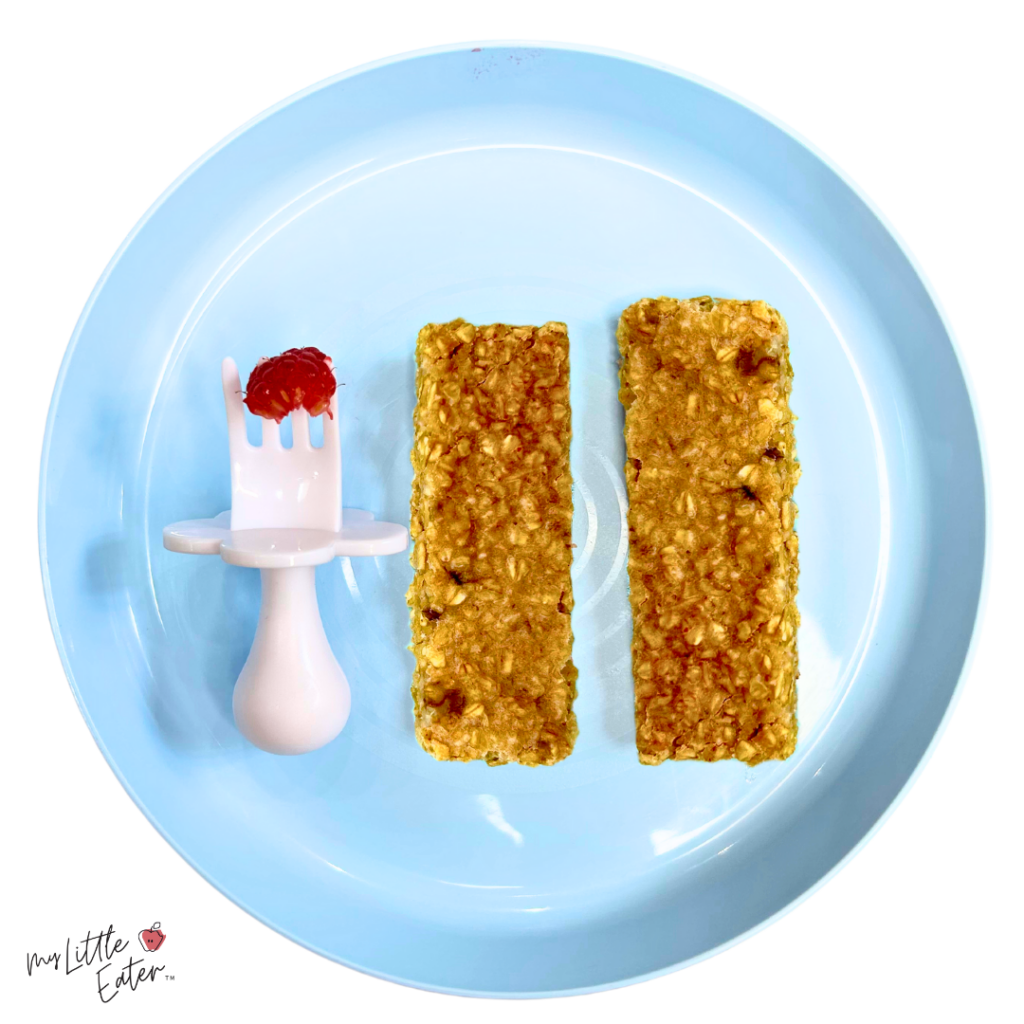
Simple swaps: For more variety, you can switch up the fruit that you serve with the oatmeal fingers. Try offering orange segments instead of raspberries for a new flavor and texture experience! You can also swap the peanut butter for almond butter, pumpkin seed butter, or soy butter to try new flavors – and the bonus is that these work great for top allergen introductions too!
Find the full recipe for banana peanut butter oatmeal fingers (including exact amounts and detailed instructions) in our 60-day baby-led feeding meal plan!
Zucchini egg omelet with ginger stewed pear
Sometimes all it takes to keep breakfast foods interesting is to prepare them differently. For example, if you usually serve your baby scrambled eggs, try serving them in the form of an omelet cut into finger shapes instead!
Add shredded zucchini into your baby’s omelet for an added boost of nutrition and serve alongside pear that has been stewed in a fragrant spice like ginger.
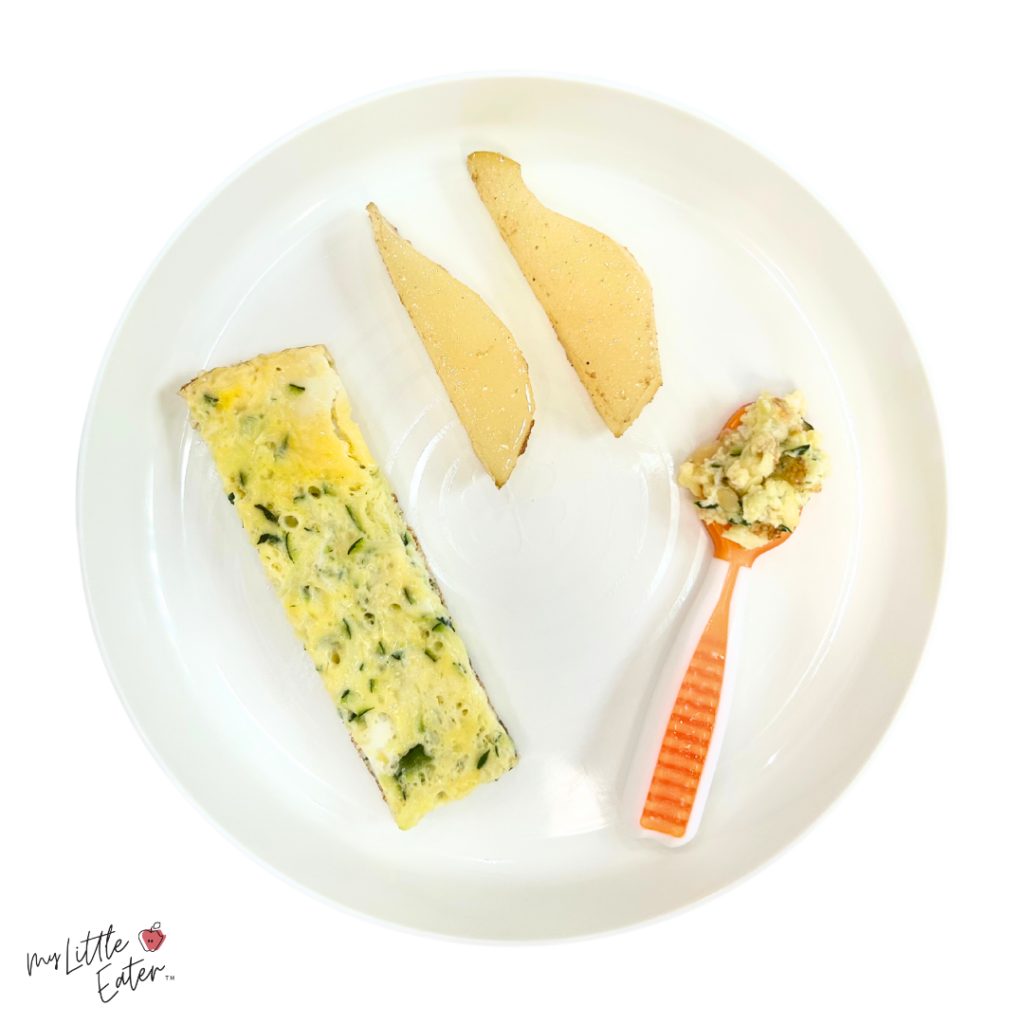
Simple swaps: For more variety, you can switch up the fruit that you serve with the omelet. Try swapping the ginger stewed pear for cinnamon stewed apple to give your baby a new flavor experience! You can also change up the veggies you include in the omelet, try cooked pieces of bell pepper, finely shredded carrots, or even some chopped green onions instead of shredded zucchini.
Find the full recipe for zucchini egg omelet with ginger stewed pear (including exact amounts and detailed instructions) in our 60-day baby-led feeding meal plan!
Deconstructed black bean burrito
Deconstructed burrito plates are a great way to safely offer the nutritious foods normally found in a black bean breakfast burrito. On a plate, serve scrambled eggs with flattened or mashed black beans, avocado wedges, and salsa.
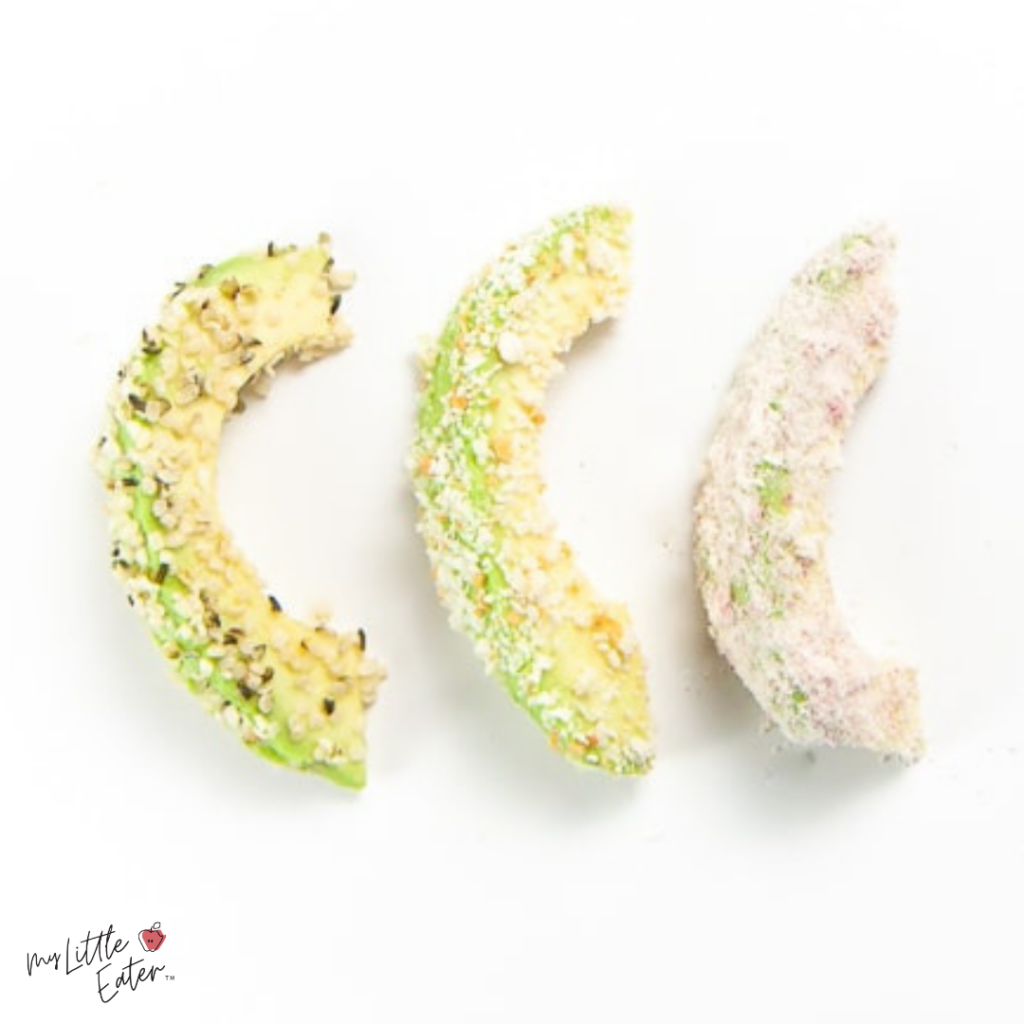
Top Tip!
Top Tip!
If the wedge of avocado is too slippery for your baby to hold onto, you can lightly roll it in wheat germ, nutritional yeast, or ground flaxseed to give it more grip and an added boost of nutrition!
When choosing salsa for your baby, look for one with low or no added salt. Or, you can also make your own salsa by combining a can of no-salt-added crushed and/or diced tomatoes with a squeeze of lime juice and spices of your choice!
Simple swap: Keep things exciting by switching up the way that you serve the eggs to your baby in this meal. Instead of scrambled eggs, try serving hard-boiled eggs cut into quarters for a new shape and texture experience!
Tropical smoothie bowl
Smoothie bowls are quick, easy, and a great way to introduce your little one to new fruits and vegetables. They’re also easy to turn into a balanced meal complete with protein, fat, and fiber.
To make a tropical smoothie bowl, add frozen banana, frozen pineapple, full-fat yogurt, full-fat milk, and hemp seeds to a blender. Top with more fruit like bite-sized pieces of banana or sprinkle hemp seeds or finely ground sunflower seeds on top for added texture.
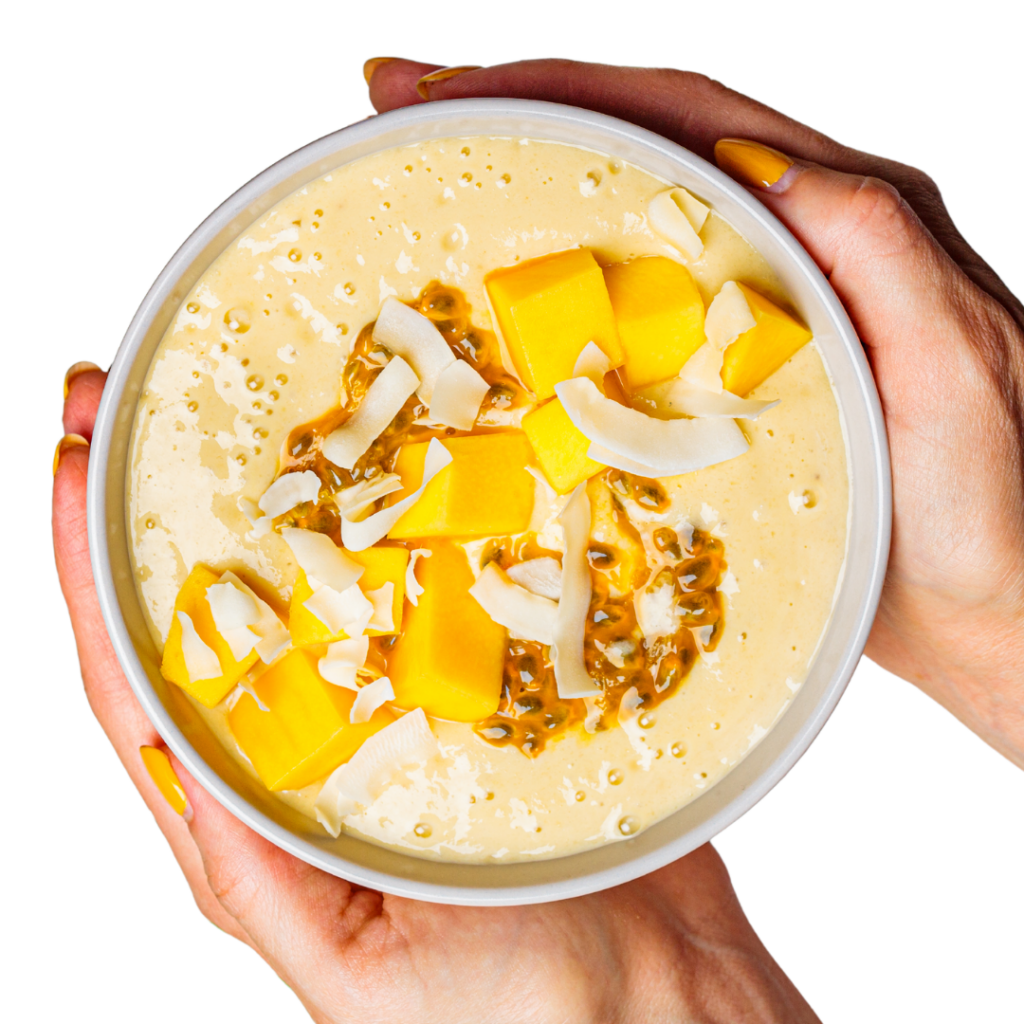
Thick smoothie bowls with toppings can be served to babies to be eaten with a spoon, similar to a puree. However, we recommend avoiding serving smoothies as a beverage until age 1 to avoid interfering with the amount of breast milk or formula that your baby is able to consume. Breast milk or formula should remain your baby’s primary source of hydration and nutrition until age 1.
Simple swaps: You can easily turn a tropical smoothie bowl into a berry smoothie bowl by swapping frozen pineapple for frozen blueberries, raspberries, or blackberries! Or, add a handful of spinach for a “green hulk” smoothie bowl!
Quinoa peanut butter porridge with blueberries
Quinoa porridge is a great alternative to oatmeal! Cook quinoa using milk instead of water, then stir in peanut butter, flattened blueberries, and ground cinnamon for a comforting, balanced breakfast.
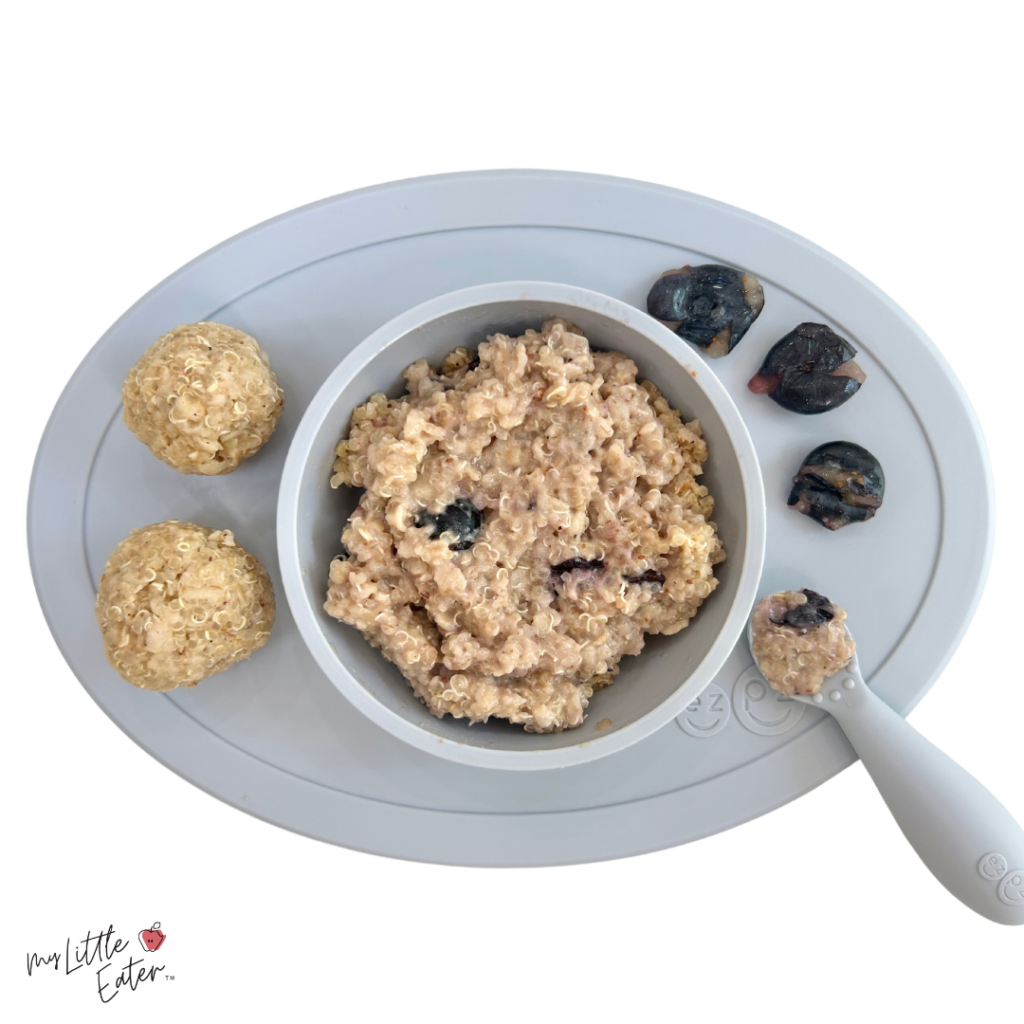
Simple swap: To transform quinoa peanut butter porridge with blueberries into carrot cake quinoa porridge, substitute flattened blueberries for grated carrot. Just add the grated carrot into the pot in the beginning along with the uncooked quinoa and milk so that it softens as the mixture cooks. You can also substitute cinnamon for another comforting spice like cardamom or nutmeg!
Find the full recipe for quinoa peanut butter porridge (including exact amounts and detailed instructions) in our 60-day baby-led feeding meal plan!
Sardine fritters with tzatziki
Sardines are one of those foods that people tend to have strong feelings about, but…babies love them! They’re also a great source of protein, iron, and healthy fats, making them an excellent food to offer to babies at breakfast (or any meal!).
Serve sardine fritters along with tzatziki as a topping or as a dip.
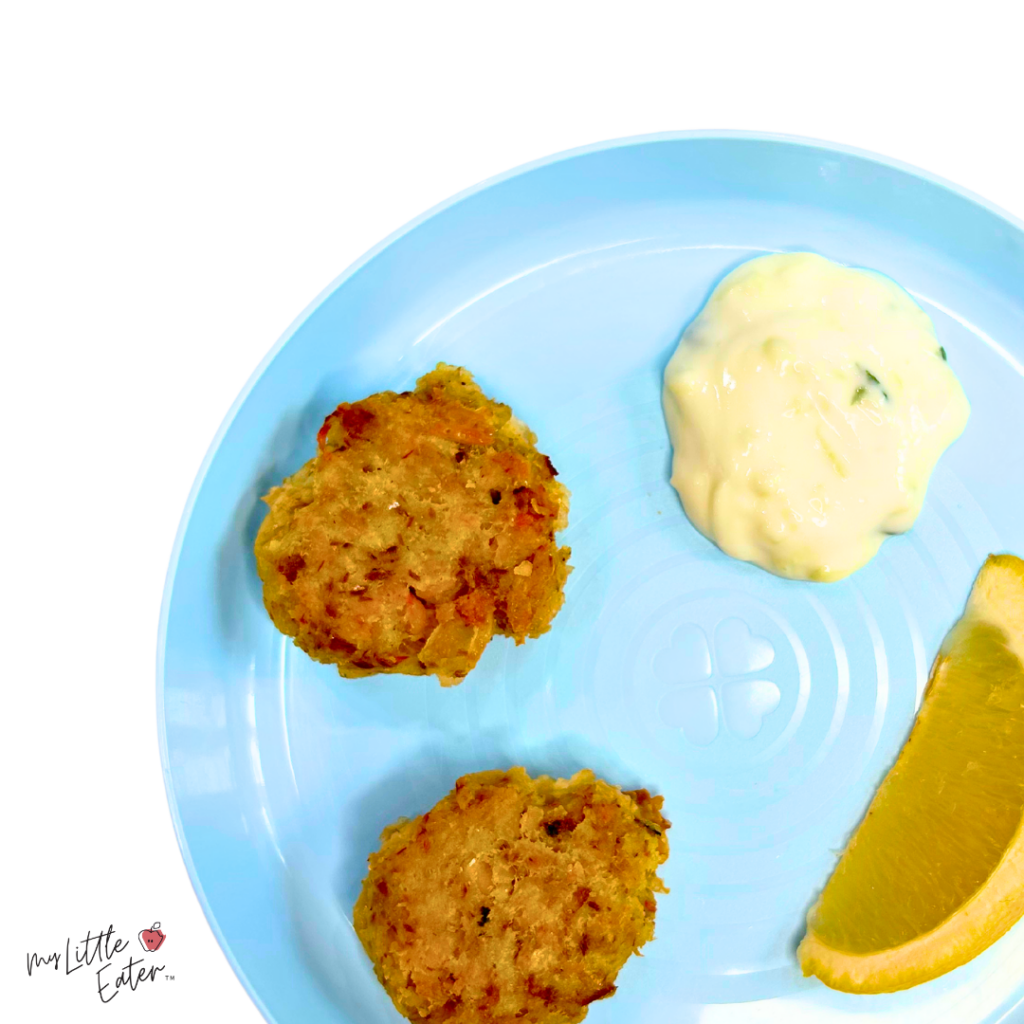
Simple swap: Sardine fritters can easily be turned into salmon fritters! Just swap out equal parts sardines for salmon (canned works for this, no need to cook a salmon fillet first thing in the morning!), and you’ve got a brand new breakfast option.
Find the full recipe for sardine fritters with tzatziki (including exact amounts and detailed instructions) in our 60-day baby-led feeding meal plan!
French toast fingers with kiwi
French toast is a quick, easy, and nutritious breakfast food for babies. Make French toast using a baby-safe bread like sourdough, then cut it into strips about 2 fingers wide. Serve alongside half of a kiwi with the peel removed for your baby to pick up using their palmar grasp.
Top tip: If the halved kiwi is too slippery for your baby to hold onto, you can lightly roll it in wheat germ, finely shredded unsweetened coconut, or ground flaxseed to give it more grip and an added boost of nutrition.
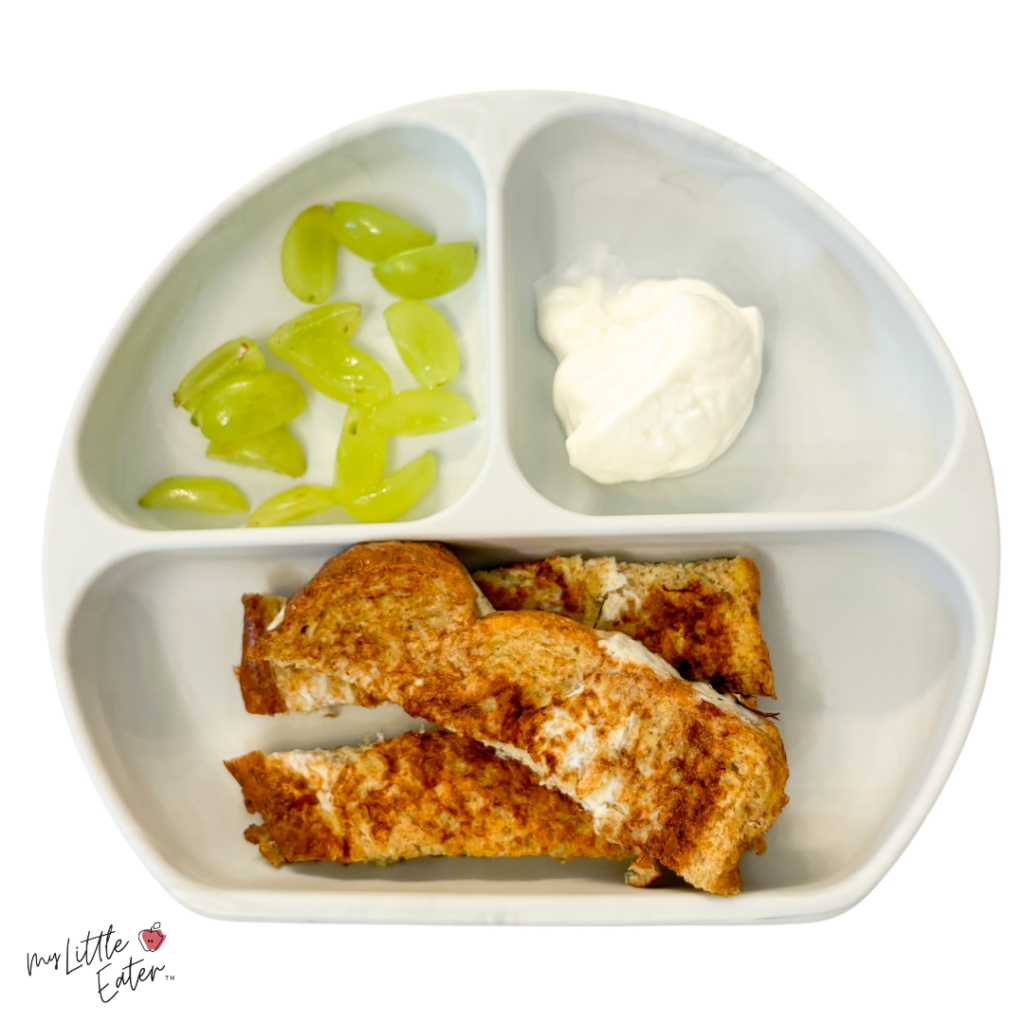
Simple swap: For more variety, you can switch up the fresh fruit that you serve with the French toast. Try swapping kiwi for peach or quartered grapes to give your baby a new flavor experience!
Strawberry coconut chia seed pudding
Pudding for breakfast has never been so nutritious! We love making chia pudding with coconut milk and adding strawberries into the mix for a touch of natural sweetness.
Simple swap: Try swapping strawberry for banana and adding a sprinkle of cardamom for a banana bread inspired chia pudding!
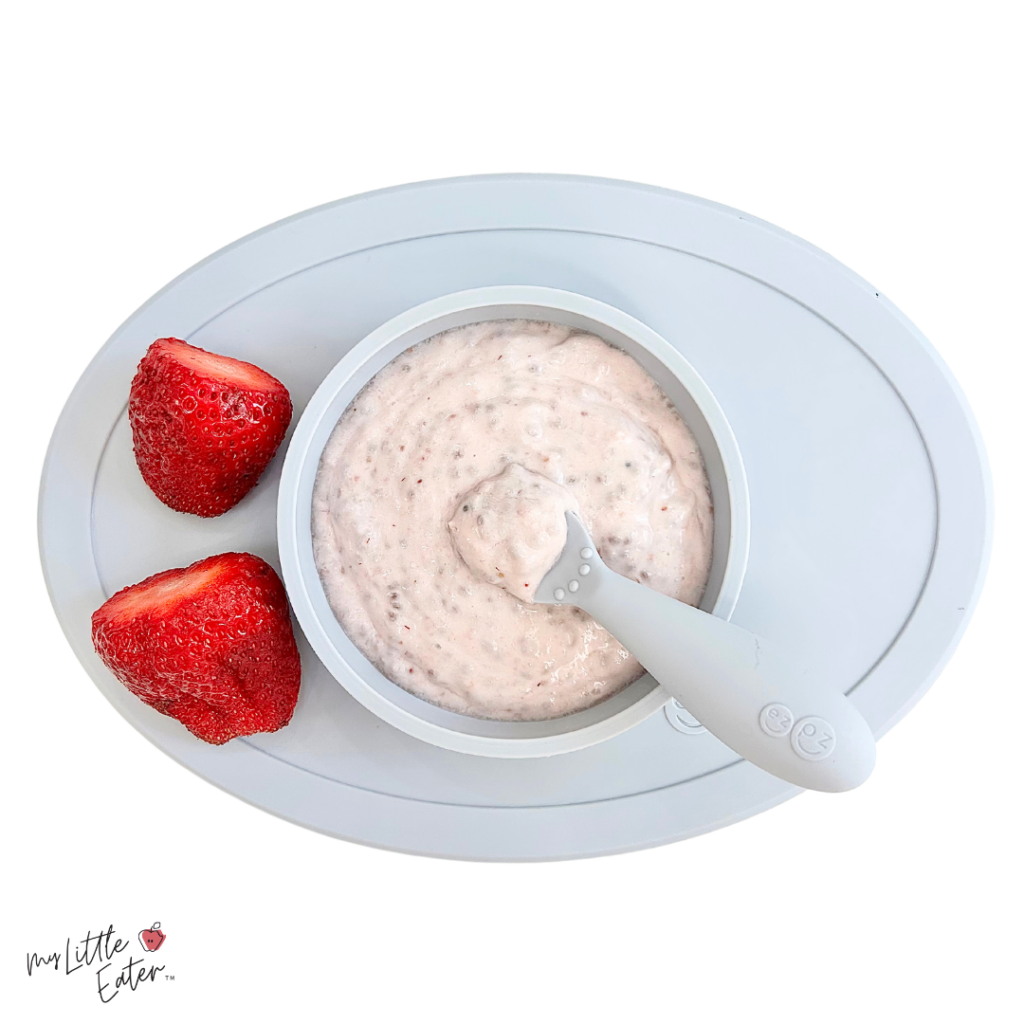
Find the full recipe for strawberry coconut chia seed pudding (including exact amounts and detailed instructions) in our 60-day baby-led feeding meal plan!
Hummus toast fingers with steamed broccoli
Toast for breakfast is a classic — plus it makes the perfect vehicle for nutritious spreads like hummus! To make hummus toast fingers, lightly toast a slice of baby-safe bread, then spread hummus on top and cut into strips about 2 fingers wide.
Serve it alongside steamed broccoli florets. That’s right…broccoli! Breakfast doesn’t always have to be served with fruit – veggies make an excellent side at breakfast too!
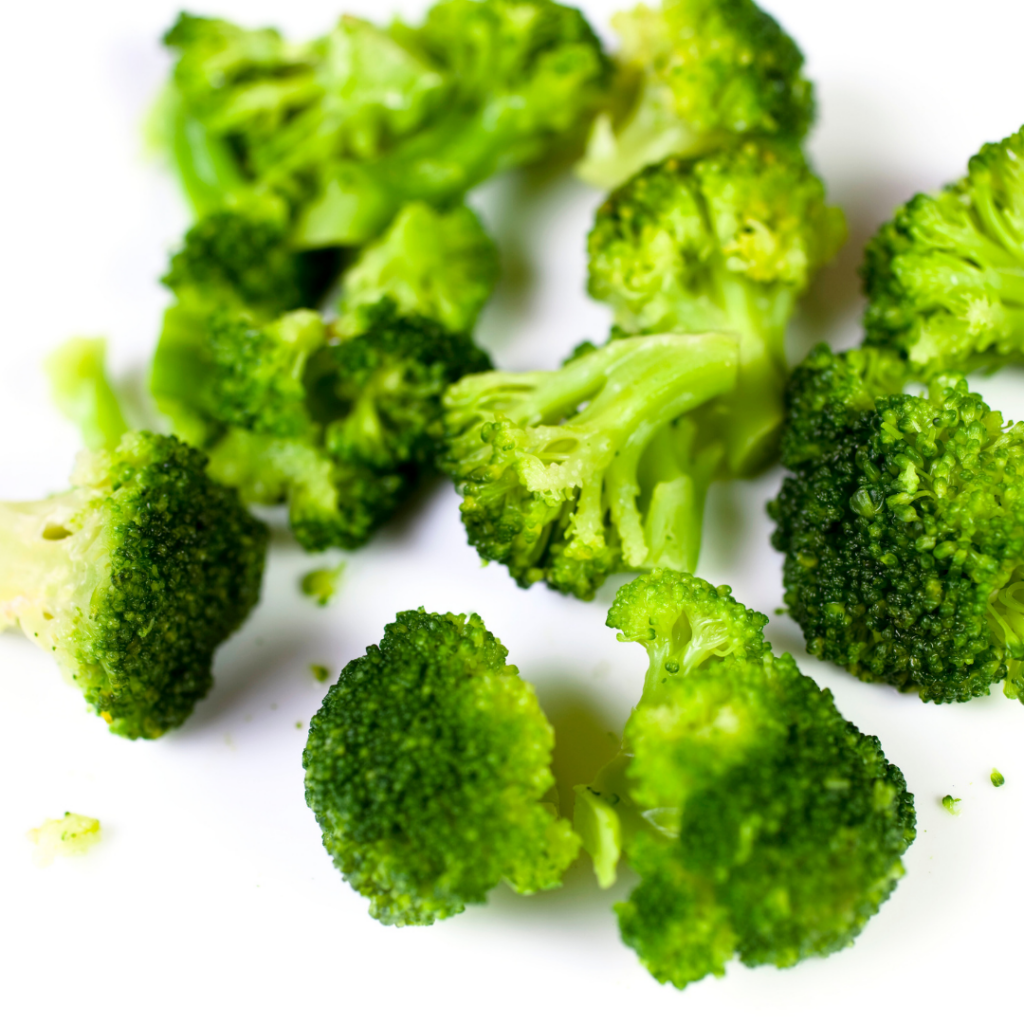
Eggplant shakshuka with toast
Shakshuka is a great way to make the classic “eggs for breakfast” new and exciting!
Shakshuka is a traditional North African and Middle Eastern dish. Typically cooked in a cast iron skillet, shakshuka is a poached egg cooked on top of tomato sauce, and often includes other vegetables and spices (1).
This dish is best for mornings when you have a bit of extra time to dedicate to cooking, as it does take about 30 minutes to put together. But, 10 of those minutes are hands-off where you can just sit back and let the poached egg do its thing!
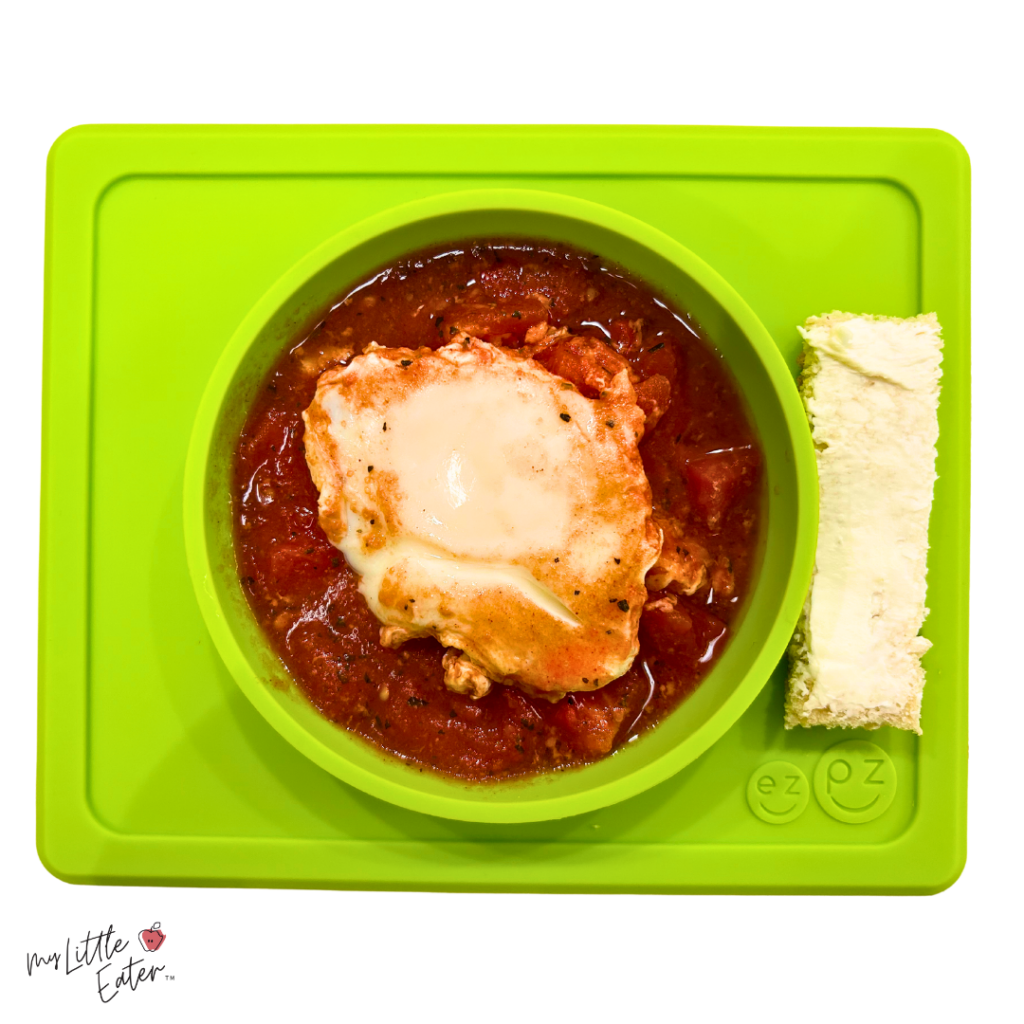
All you need to make this eggplant shakshuka is eggs, eggplant, tomatoes, oil, and spices. Serve shakshuka to your baby with buttered toast fingers on the side for your baby to pick up using their palmar grasp.
Simple swap: For more variety, swap buttered toast fingers for rice or couscous on the side.
Find the full recipe for eggplant shakshuka with toast (including exact amounts and detailed instructions) in our 60-day baby-led feeding meal plan!
Coconut mango oatmeal
Oatmeal is a quick, easy, and nourishing breakfast option for babies. We love to make oatmeal extra creamy by mixing in coconut cream (the solid part from a can of coconut milk) after the oatmeal has been cooked. Top the oatmeal with mango, or serve pieces of mango on the side.
Top Tip!
Top Tip!
Roll up oatmeal into balls (about 2 tbsp in size) to provide your baby with a finger food version of oatmeal that they can pick up using their palmar grasp!
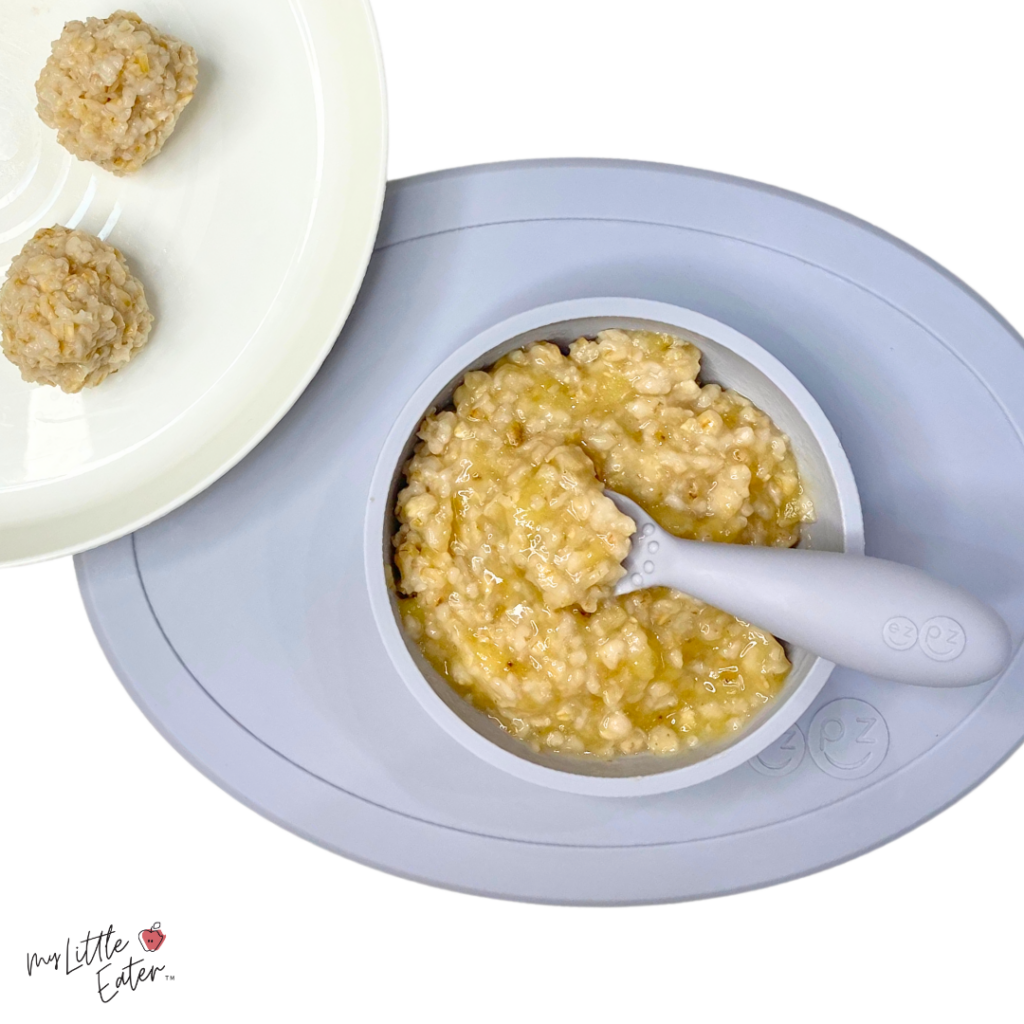
Simple swap: For variety, turn oatmeal into a savory breakfast by swapping mango for avocado, and coconut cream for mashed white beans!
Curried tofu scramble with steamed bell pepper
If you’re looking for a twist on scrambled eggs, give scrambled tofu a try! Tofu can be made into a scrambled egg-like texture when crumbled and cooked with a few spices like nutritional yeast and curry powder.
Pair curried tofu scramble with steamed bell pepper. The high vitamin C content of bell pepper will help boost the absorption of the plant-based iron found in tofu (2).
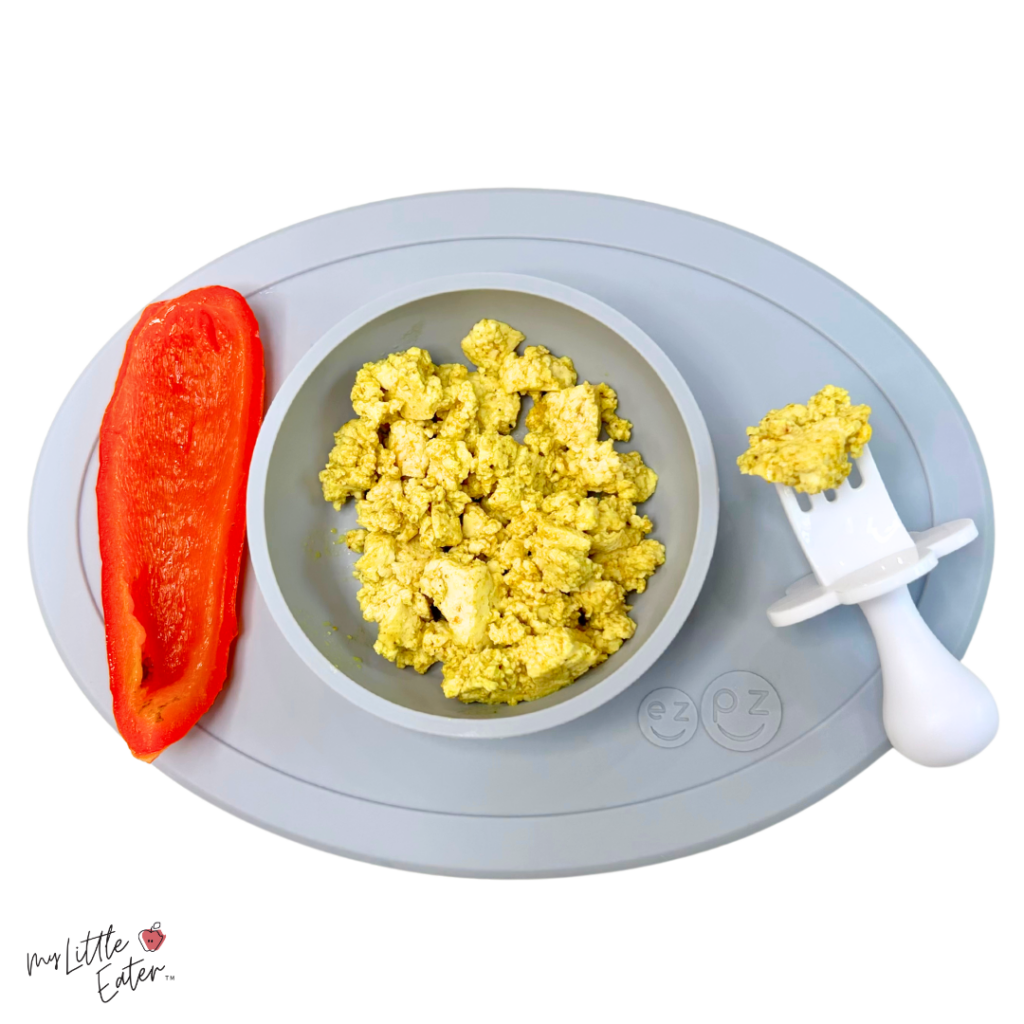
Simple swap: For variety, you can swap steamed bell pepper for another source of vitamin C like tomato or orange wedges. You can also swap the curry powder for another spice like dill or turmeric to introduce your baby to a new flavor.
Find the full recipe for curried tofu scramble with steamed bell pepper (including exact amounts and detailed instructions) in our 60 day baby-led feeding meal plan!
Yogurt parfait
Yogurt parfaits are a nutritious and versatile breakfast option for babies. Plus, the best part is…they take less than 5 minutes to make!
Start with full-fat yogurt, then mix in some of your baby’s favorite nut butter. Top the yogurt mixture with fruit like diced strawberries, diced bananas, or quartered blueberries.
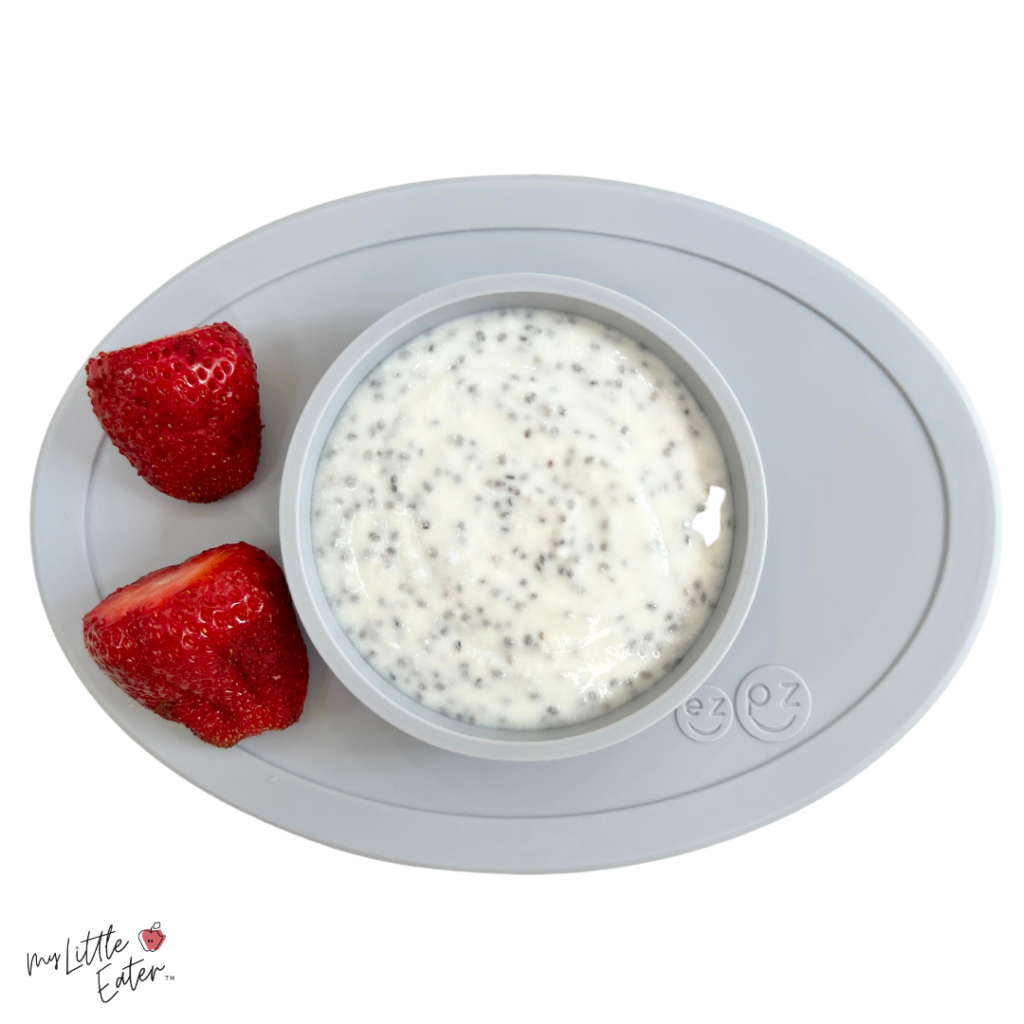
Simple swaps: Try swapping nut butter for pumpkin or sunflower seed butter! You can also turn this into a chia seed yogurt parfait by mixing chia seeds into the yogurt instead of nut butter before topping it with the fruit of your choice. Just let the chia seeds sit in the yogurt for 5-15 minutes before serving to allow them to expand.
Almond banana pancake fingers with raspberries
Who doesn’t love pancakes? You can make these with just 3 simple ingredients — almond butter, banana, and egg! Cut each pancake into strips about 2 fingers wide, then mash raspberries and spread them onto the pancake fingers or serve flattened raspberries on the side for your baby to pick up using their pincer grasp.
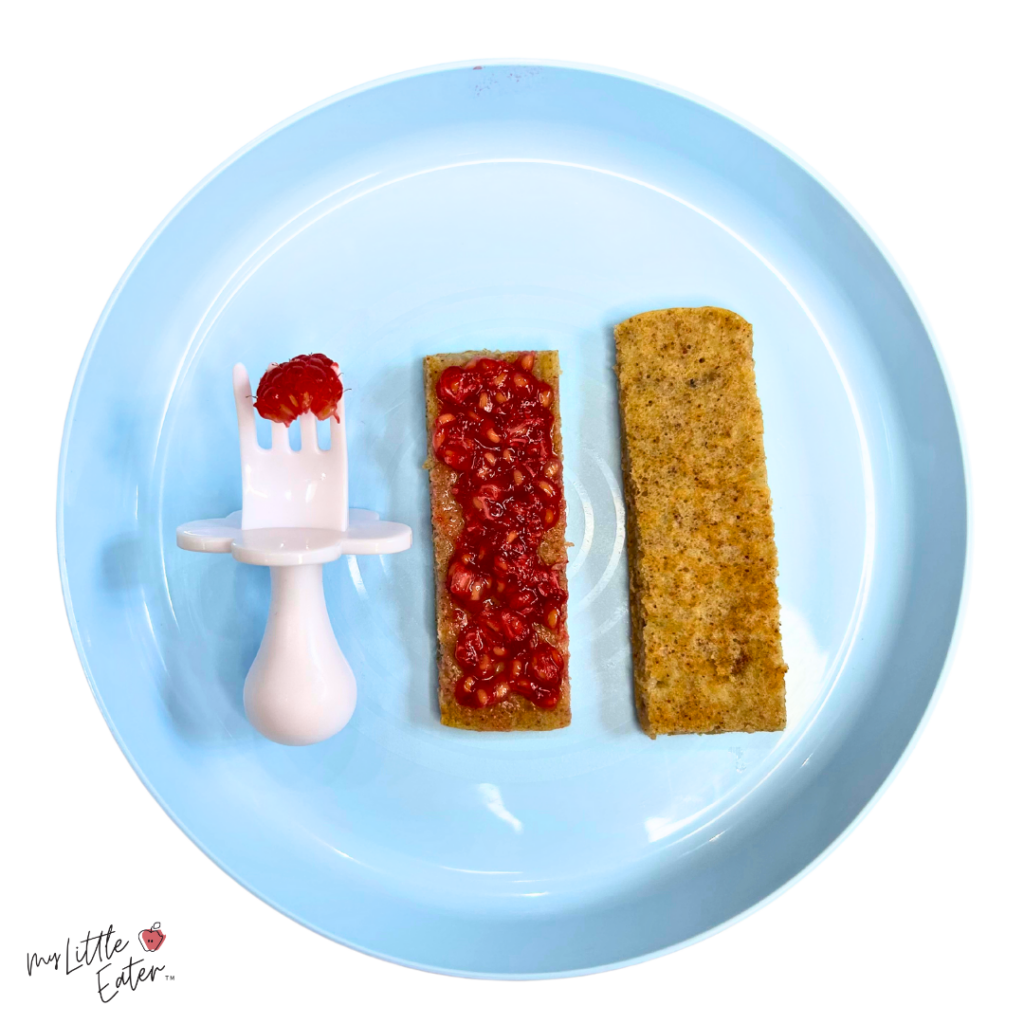
Simple swap: For more variety, switch up the type of nut or seed butter you use to make the pancakes. Peanut butter, cashew butter, and sunflower seed butter all work well! You can also swap raspberries for another fruit like blackberry.
Find the full recipe for almond banana pancake fingers (including exact amounts and detailed instructions) in our 60-day baby-led feeding meal plan!
Time-saving tip: Freeze your pancake batter into individual portions
For those busy mornings when mixing batter in a bowl just feels too time-consuming, we’ve got the perfect time-saving trick to help you make pancakes fast!
It just requires a little bit of planning and under 5 minutes of low-effort prep!
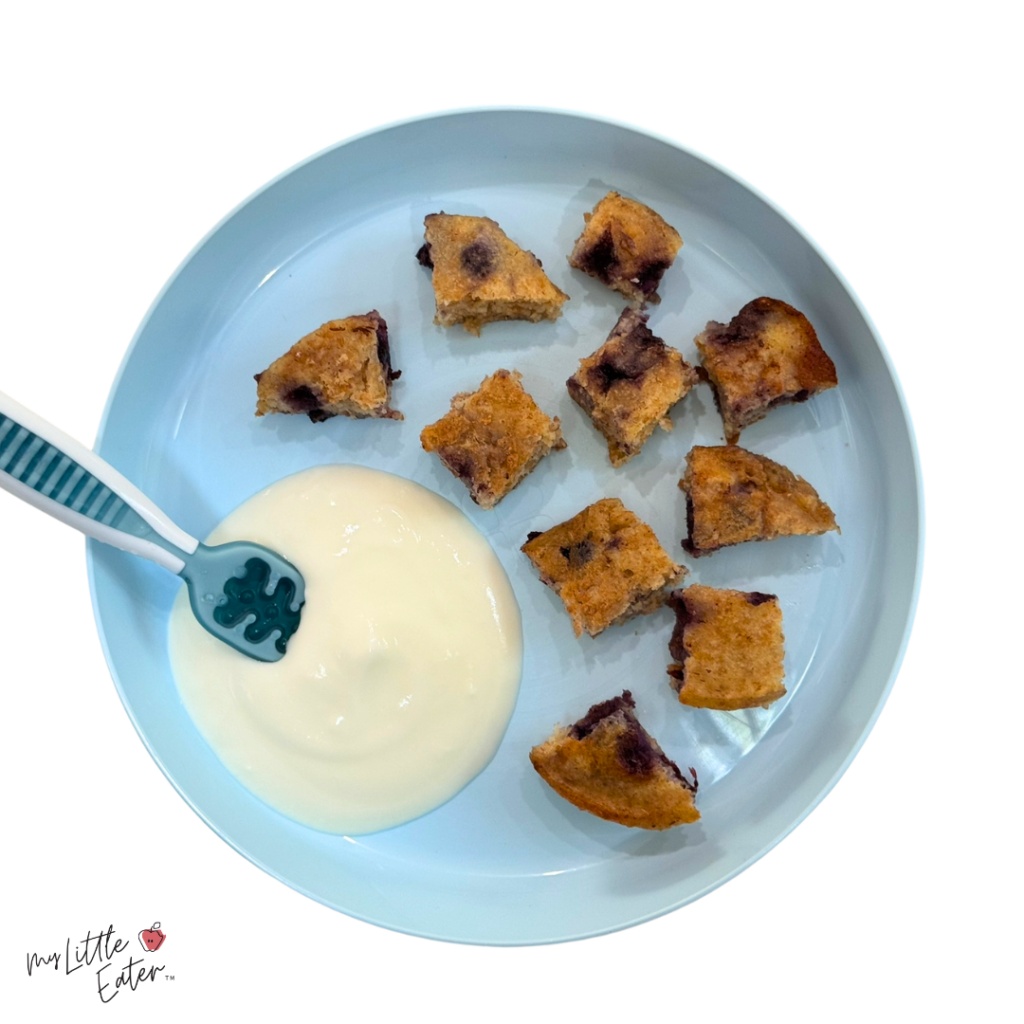
Step 1: Prepare pancake batter using a standard pancake recipe (check out our recipe for pancake batter at the end).
Step 2: Pour 2 tbsp of pancake batter into each muffin cup of the silicone tray (it’s important not to overfill them!).
Step 3: Place the filled silicone muffin tray into the freezer (at least 4 hours or overnight). Once frozen solid, pop the pancake batter pucks out of the muffin tray and store them in an airtight container or plastic bag in the freezer until you’re ready to use them.
Step 4: When you’ve decided that it’s a pancake morning, drop your desired number of frozen pancake pucks into a greased pan over low-medium heat. Let the pancakes cook for 2-3 minutes covered until small bubbles appear on the surface, flip them over, remove the cover, then cook for 2-3 more minutes.
Step 5: Serve your baby these mini pancakes for them to pick up with their palmar grasp, or cut the pancakes into ½-1 inch pieces for them to pick up with their pincer grasp.
The frozen pancake batter pucks can be stored in the freezer for up to 2 months.
Polenta with tomatoes and chickpeas
Polenta is a great savory alternative to hot breakfast cereal like oatmeal. We love adding grated parmesan cheese into the polenta for extra creaminess, then topping it with a mixture of tomato and flattened chickpeas cooked in Italian spices!
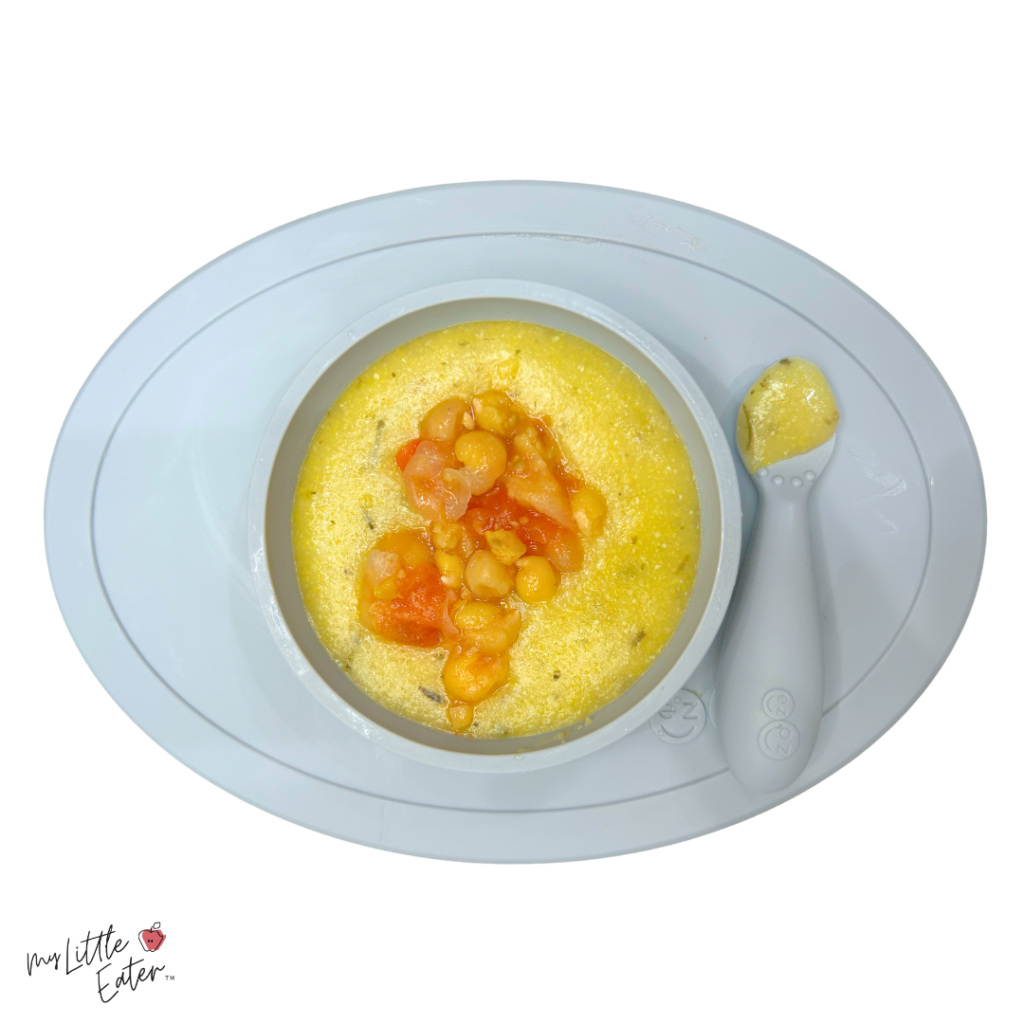
Simple swap: For variety, you can substitute chickpeas for another legume like cooked red lentils or kidney beans.
Find the full recipe for polenta with tomatoes and chickpeas (including exact amounts and detailed instructions) in our 60-day baby-led feeding meal plan!
Now that you’ve got a huge list of ideas to use, let’s get into the details of how to create a balanced breakfast for your baby, the nutrition you should consider for breakfast time, and finally one of our favorite, easy-to-make breakfast recipes!
Is breakfast the most important meal of the day?
Growing up, you were probably told this a time or two – but is it true?
Breakfast IS important, but is it more important than lunch or dinner? Not necessarily…not for babies anyway! A single meal like breakfast won’t make or break your baby’s progress with eating solid foods. What’s most important is the overall variety of foods and textures that they’re offered early on in their feeding journey – whether that be at breakfast, lunch, or dinner!
That being said, some parents have told us that their baby tends to eat best at breakfast and that they seem to be a more adventurous eater after having gone all night without any solid food.

If this sounds like your little one, all the more reason to take advantage of breakfast as a time to introduce new foods and food textures. But that also means that you’ll need to be open to serving non-traditional breakfast foods so you can keep that variety going and avoid getting stuck in a rut!
Breakfast is also a great time to introduce top allergenic foods for the first time (we’ll get into the reasons why in more detail soon).
Research also shows that children who regularly eat breakfast have higher intakes of important nutrients like fiber, iron, B vitamins, and vitamin D (3,4). Eating breakfast may also help to support a healthy body weight in children (5).
Plus, it has been shown to benefit behavior, focus, and performance at school (6).
When your baby starts eating 3 meals per day we definitely want one of those to be breakfast, so we recommend getting into the habit of offering it sooner rather than later!
What to feed babies for breakfast
You probably noticed that among the breakfast ideas we shared, not all of them are typical “breakfast foods”. This is intentional – we’re firm believers that you don’t have to serve “breakfast foods” at breakfast.

Many options commonly marketed as “breakfast foods” like packaged cereal, oatmeal, and flavored yogurts contain lots of added sugar. However, most major health organizations agree that added sugar should be limited or avoided completely until age two (7,8,9,10,11).
Don’t let this information scare you — there are plenty of other foods that you can offer your baby for breakfast that have zero added sugar. It doesn’t have to be complicated!
We love using leftovers from a family meal and repurposing them into a balanced breakfast for your baby. So go ahead and serve that leftover pasta and meatballs in the morning…we promise your baby won’t know the difference. To them, it’s just another food!

In fact, the more often you can incorporate savory foods like vegetables, meat, and legumes at breakfast, the better! Consistent exposure to these foods can help your baby be more willing to accept and try them when they show up at meals later on (12).
It can also help to take certain foods off a pedestal by teaching your little one that all foods are on an equal playing field and can show up at any meal, at any time of the day.
Key Takeaway!
We give you full permission to break the “rules” and think outside of the box when it comes to the types of foods you serve at breakfast. What’s most important is to provide your baby with balanced meals that contain a variety of nutrient-dense foods to meet their nutrition needs.
Key Takeaway!
We give you full permission to break the “rules” and think outside of the box when it comes to the types of foods you serve at breakfast. What’s most important is to provide your baby with balanced meals that contain a variety of nutrient-dense foods to meet their nutrition needs.
How to build a balanced breakfast
Let’s talk about the foundations of what makes a balanced meal for your baby so that you can put together endless combinations with confidence and never run out of breakfast ideas again!
The formula is simple. When building a balanced breakfast, you’ll want to include a high-iron food, a high-calorie food, and produce. Let’s break each one down.
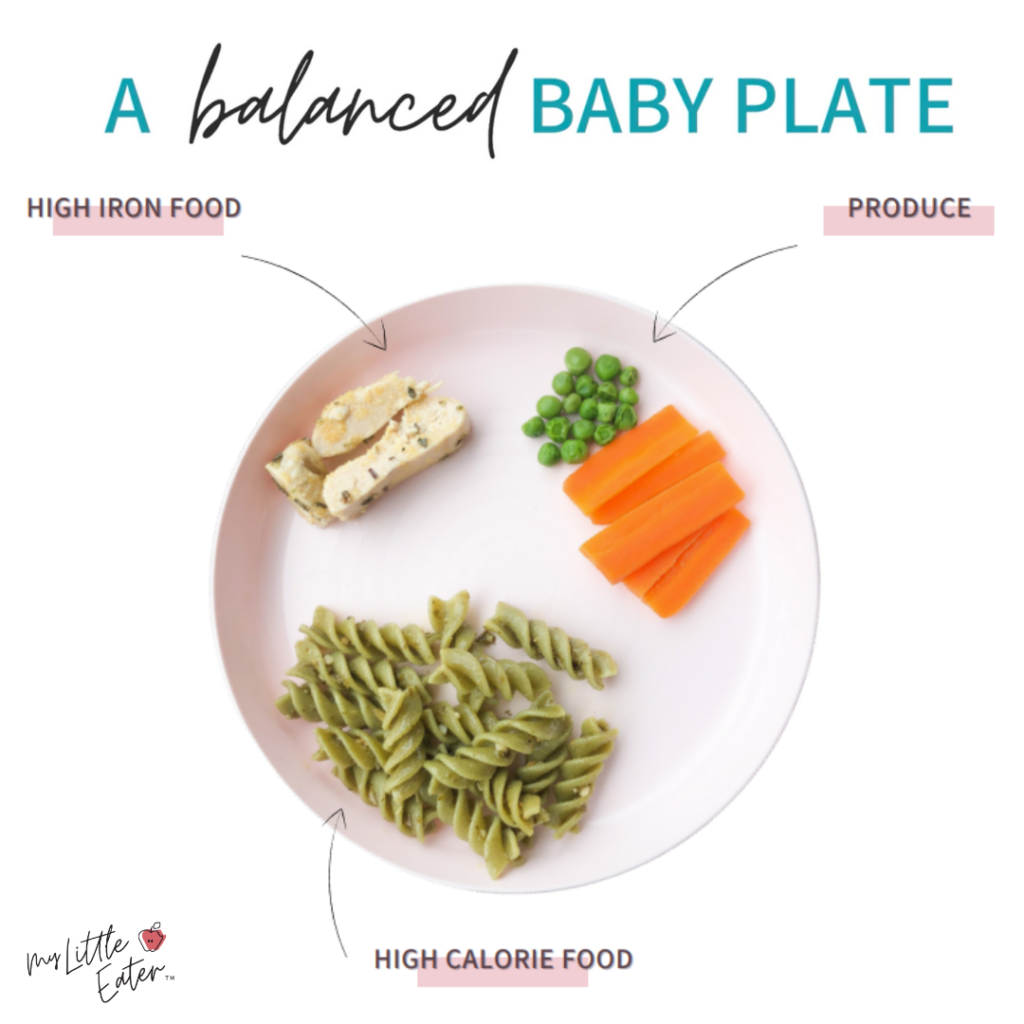
Iron
Iron is an important nutrient for your baby’s growth and development, and by the time they reach around 6 months of age, their iron stores start to become depleted. This means that your baby will need to start getting iron from solid food (13,14).
We recommend aiming to include an iron-rich food in each of your baby’s meals, including breakfast.
Examples of high-iron foods to serve at breakfast include eggs, beans, lentils, tofu, iron-fortified cereal, meat, poultry, and even fish (remember, non-typical breakfast foods are encouraged!).
High-calorie
Babies grow more quickly during their first year of life compared to any other time, therefore, they need enough calories and nutrients to support this period of rapid growth and development (15).
Including sources of healthy fat in meals is an excellent way to do this, as fat contains more calories per gram than any other macronutrient at 9 kcal per gram. Food sources of fat that you can add to meals for your baby include full-fat yogurt and cheese, coconut milk, butter, ghee, and egg yolk.
Unsaturated healthy fats like omega-3s are especially essential to your baby’s growth and development (16). Specifically, a type of omega-3 called docosahexaenoic acid (DHA) which is important for brain development and eye health (17).
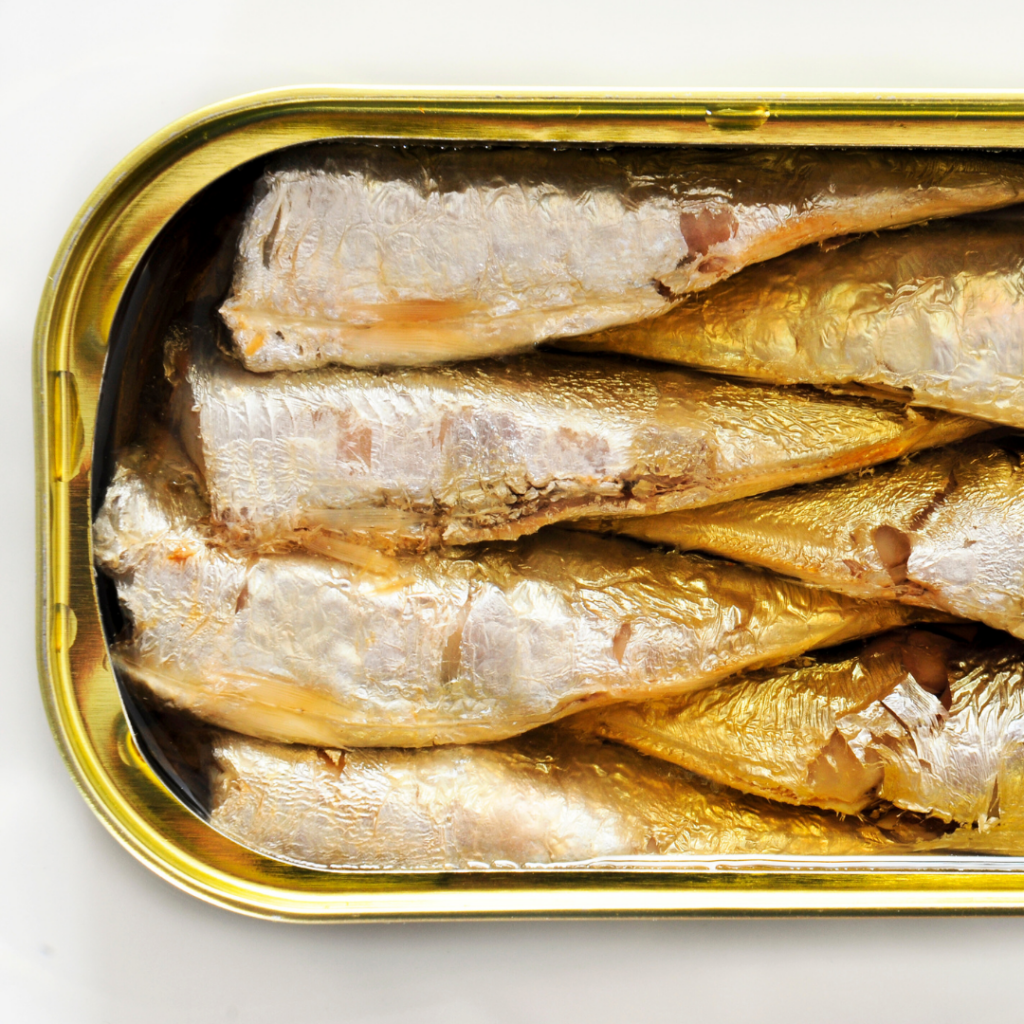
The best food sources of healthy omega-3 fats are fatty fish like salmon, mackerel, herring, and sardines, however, omega-3 is also found in plant food sources like walnuts, flaxseed, and chia seeds (18). All of which can be included in a balanced breakfast for your baby!
Starchy foods like whole grains and starchy vegetables also fit into the category of high-calorie foods for babies. Aside from being a good source of calories, they also provide fiber and essential vitamins and minerals (19,20).
Examples of starchy foods to include at breakfast for babies are quinoa, oats, bread, bananas, squash, and potatoes.
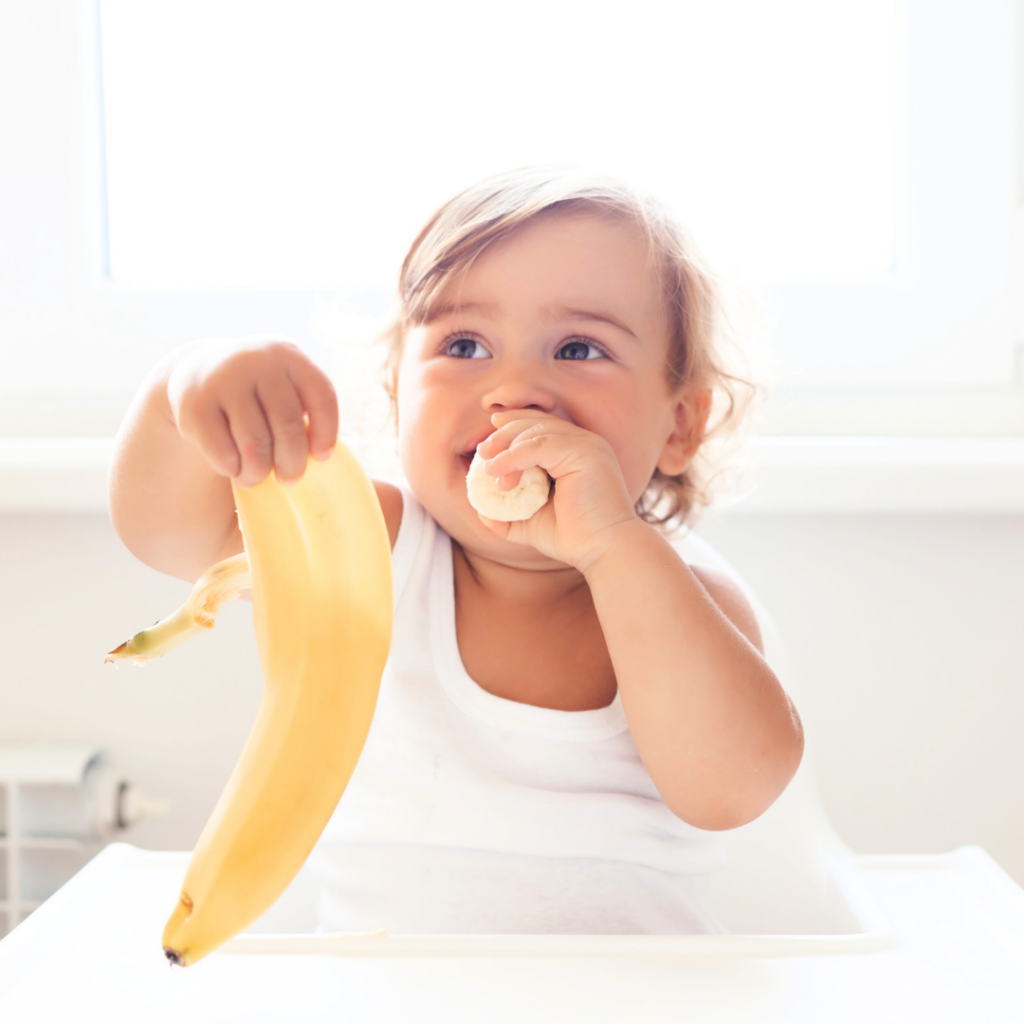
Produce
We’re big advocates for including produce at every meal to help balance out your baby’s plate!
Fruits and vegetables provide important vitamins and minerals that are essential for your growing baby (21). Plus, many fruits and vegetables include vitamin C, which can help increase the absorption of iron in that same meal (22).
Beyond that, giving your baby exposure to different foods early on when starting solids can influence their taste and food preferences (23,24). Serving produce regularly can therefore be helpful in getting your baby to like and accept fruits and vegetables (12).
This is a huge bonus because it’s very common for babies and toddlers to not eat enough of either (25).
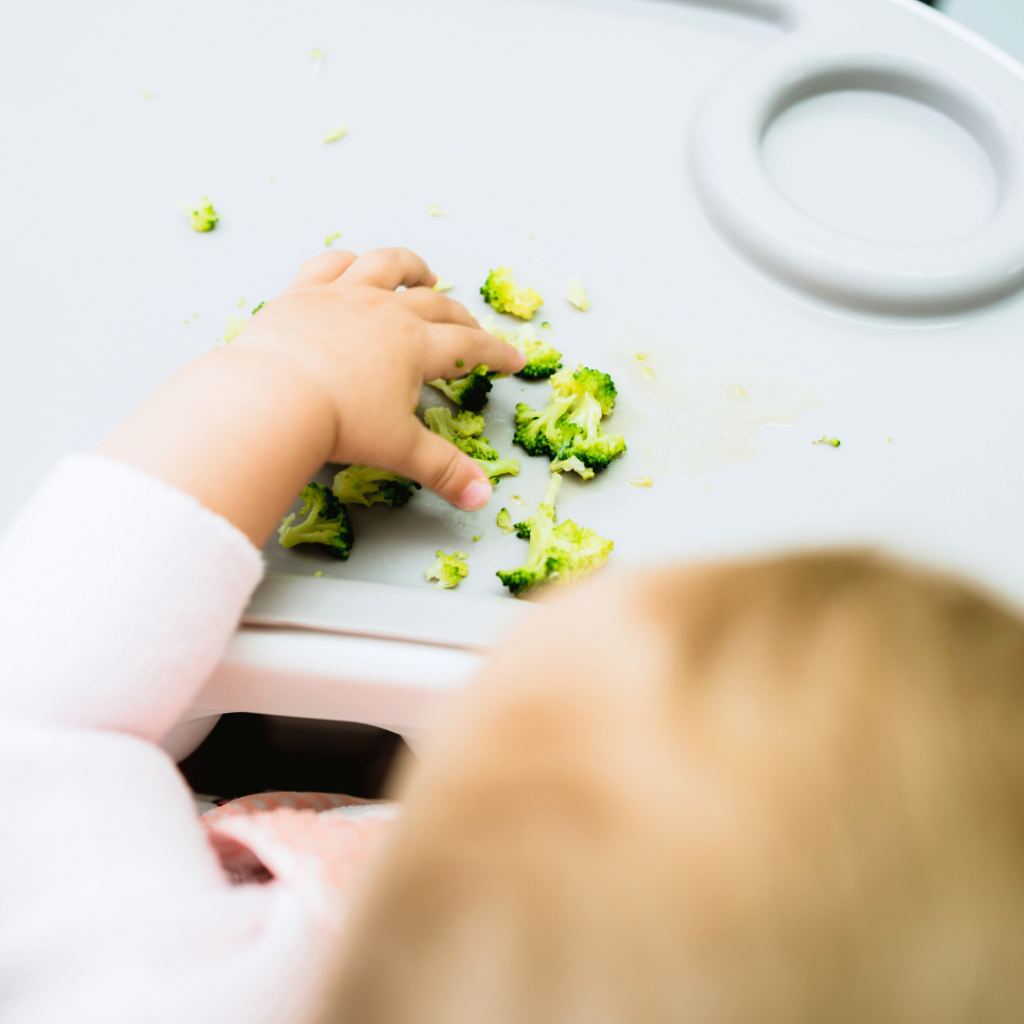
How much should babies eat at breakfast?
The sort of annoying but realistic answer is…it depends! Each baby is different and has their own unique needs. There are so many factors that can influence the amount that your baby will eat from day to day and even from meal to meal.
We understand how easy it is to get caught up in tracking the amount that your baby eats at each meal, but the truth is, how much your baby eats isn’t as important as you might think. From 6-12 months, breast milk or formula remains your baby’s primary source of nutrition providing 50% or more of your baby’s energy needs (7).
Don’t get us wrong…we’re not saying that solids aren’t important during this time – they definitely are! But, providing your baby with consistent exposure to new foods and allowing them to practice and learn how to eat is far more important than the amount that they eat at this age.

Plus, babies are really good at recognizing and honoring their feelings of hunger and fullness (26). You can trust that your baby will eat the amount that’s right for them at meals – breakfast included.
Learn more about why we don’t recommend getting hung up on portion sizes for your baby.
How to maintain variety at breakfast
The importance of exposing your baby to different flavors goes beyond just fruits and vegetables!
In the early months of starting solids, babies are developing their food and flavor preferences and are generally more willing to try new foods compared to during their toddler years (27). Because of this, it’s a good idea to take advantage of this window of opportunity to introduce them to a variety of different foods, textures, and flavors.
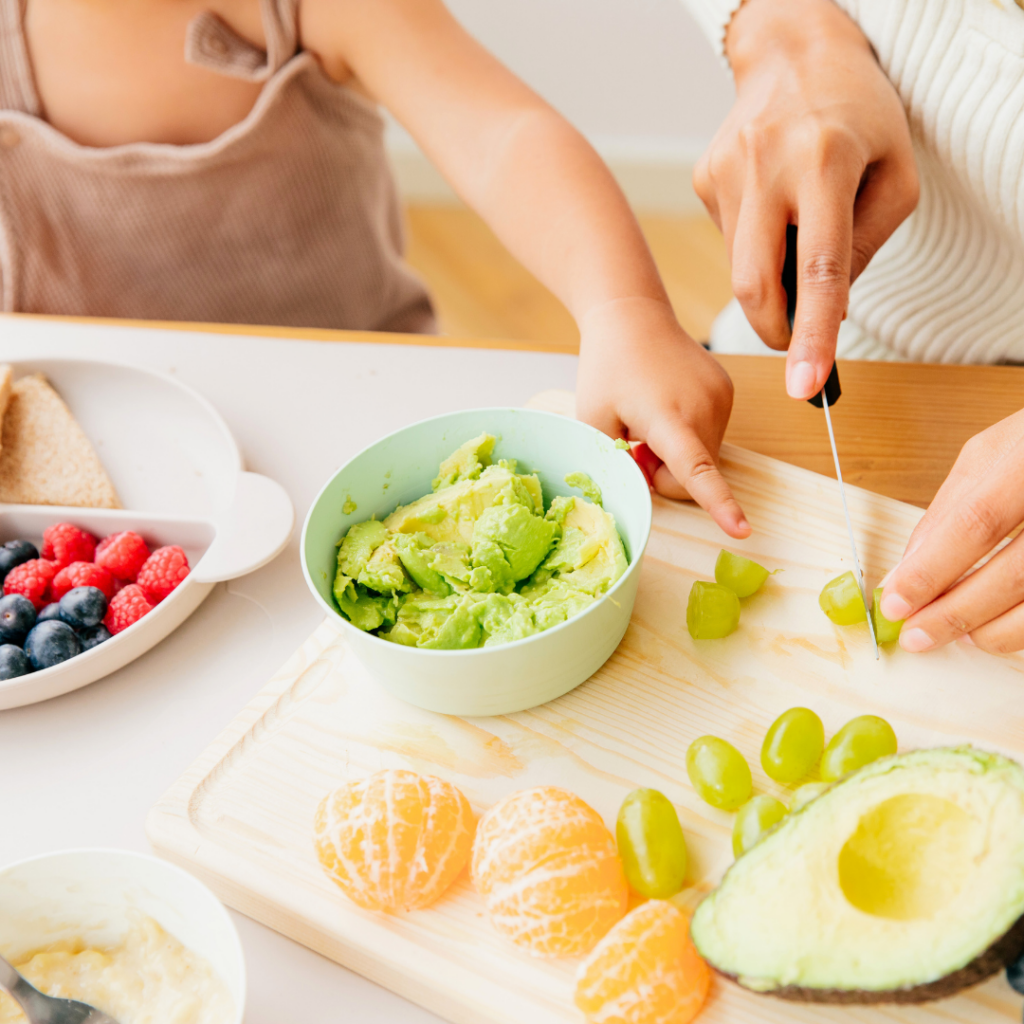
Making small changes and swaps to breakfasts that are already in rotation is an excellent way to maintain variety with little to no added effort on your part. Simple swaps can be things like switching up the spice used in a recipe, changing the fruit served alongside a meal, using hemp seeds as a topping, or even just cooking eggs differently!
Check out the simple swaps in each of the baby breakfast ideas listed above!
When to serve breakfast
Aim to serve your baby breakfast between 30-90 minutes after their morning bottle or nursing session.
While every baby is different, this is usually enough time to allow them to develop hunger. The goal is to have your baby go into the meal hungry enough to be interested in trying solid food, but not so hungry that they’re too frustrated to eat, explore, and enjoy the meal.
Once your baby is a bit older and no longer has a morning bottle or nursing session, you can serve breakfast whenever it works best for your family!
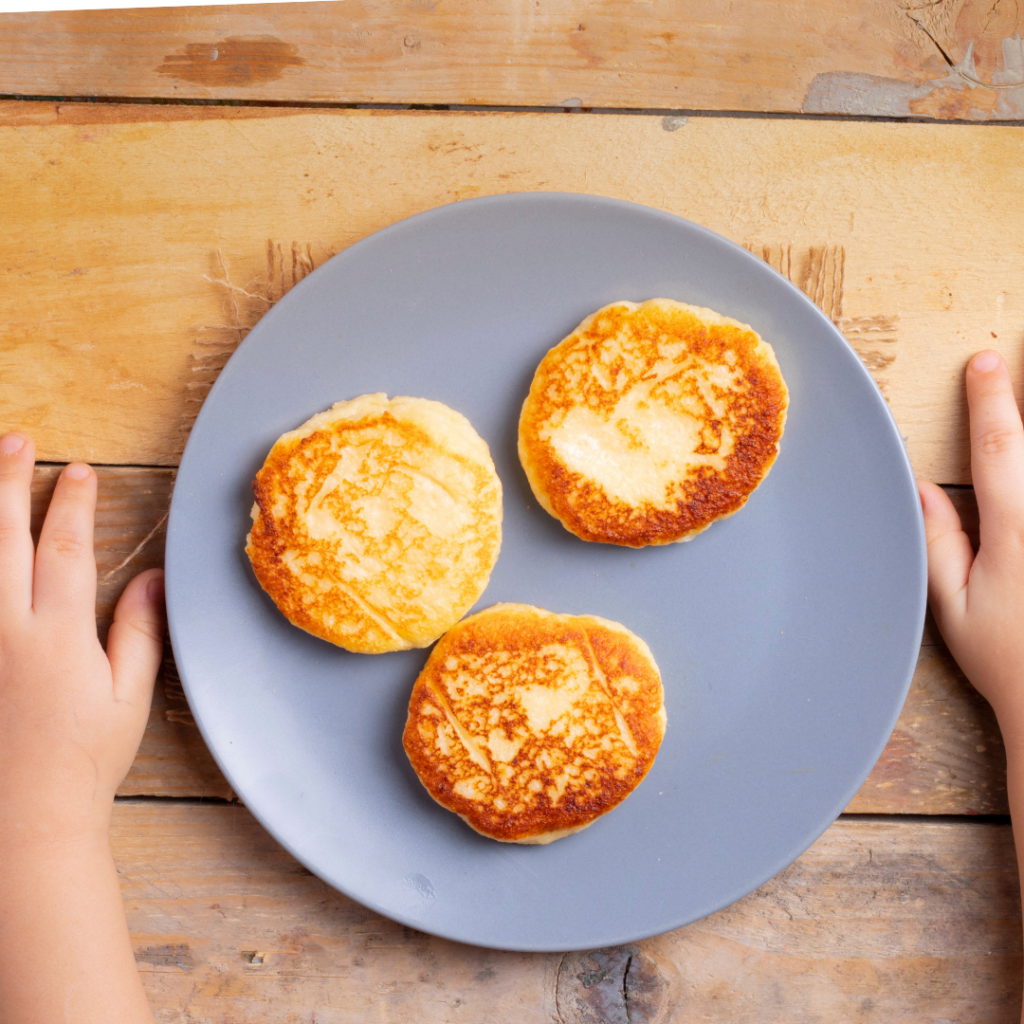
Be prepared that in those first few weeks or even month(s) after cutting out their morning nursing session or bottle, your baby may not be able to wait too long for their breakfast without becoming very fussy. Try to prep breakfast the night before as much as you can to help make this transition easier for everyone!
Read more about navigating milk and solid food feeding schedules as your baby grows.
Introducing top allergens at breakfast
It’s recommended to introduce top allergenic foods to your baby early (close to the time of starting solids at 6 months) to help minimize the risk of developing allergies to these foods (28,29).
When introducing allergens for the first time, it’s important to monitor your baby closely afterward for signs of an allergic reaction. Symptoms of an allergic reaction usually appear anywhere from a few minutes up to 2 hours after eating (30). Because of this, most parents find it easiest to introduce highly allergenic foods at breakfast to allow for enough time to stay close by and monitor their baby before the next nap or activity outside of the house.
Learn more about our recommended protocol for introducing highly allergenic foods.
We hope that you’re feeling confident and ready to take on breakfast again now that you have 30+ new balanced breakfast ideas to try out! But, just in case you’re not feeling inspired yet…here’s another idea!
Scrambled pancake recipe
The latest food trend taking social media by storm…scrambled pancakes! Don’t let their scrambled egg-like appearance fool you, scrambled pancakes are just as delicious as classic pancakes, but with a fun new texture for your baby to explore!
Scrambled pancakes aren’t new – they’re actually inspired by a sweet traditional Austrian dish called “Kaiserschmarrn” (31). Kaiserschmarrn, commonly described as “shredded pancakes”, is said to be traditionally served alongside applesauce or plum compote.
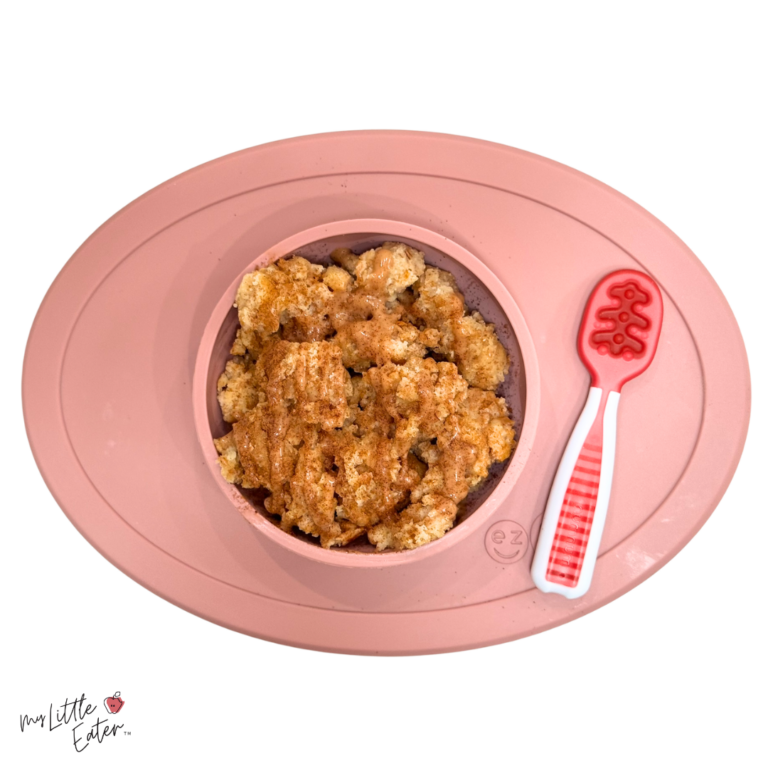
SCRAMBLED PANCAKES (KAISERSCHMARRN)
Equipment
- 2 bowls
- 1 pan
Ingredients
- 1 ¼ cup whole wheat flour
- 2 tsp baking powder
- 2 eggs
- ½ cup yogurt
- ¾ cup milk
- 2 tbsp melted butter (unsalted) (+1 tbsp for frying pan)
- ½ tsp vanilla extract
Instructions
- In a medium sized bowl. whisk together whole wheat flour and baking powder.
- In a separate bowl, whisk together eggs, milk, yogurt, melted butter and vanilla extract.
- Gradually add wet ingredients to the dry mixture, and stir until well combined.
- Heat pan over medium high heat with 1-2 tbsp butter and add batter (about 1 cup, spread flat like one big pancake). Let cook untouched for 1-2 minutes until bubbles are appearing, then start to scramble using a spatula to break up the mixture into large pieces. Cook for another 2-3 mins until the pieces are all cooked through.
- Allow scrambled pancakes to cool, then serve to your baby for them to pick up using their palmar or pincer grasp.
Notes
Looking for more baby friendly meal ideas? Check out our 60-Day Baby Led Feeding Meal Plan!

Pin to save these baby breakfasts for later!
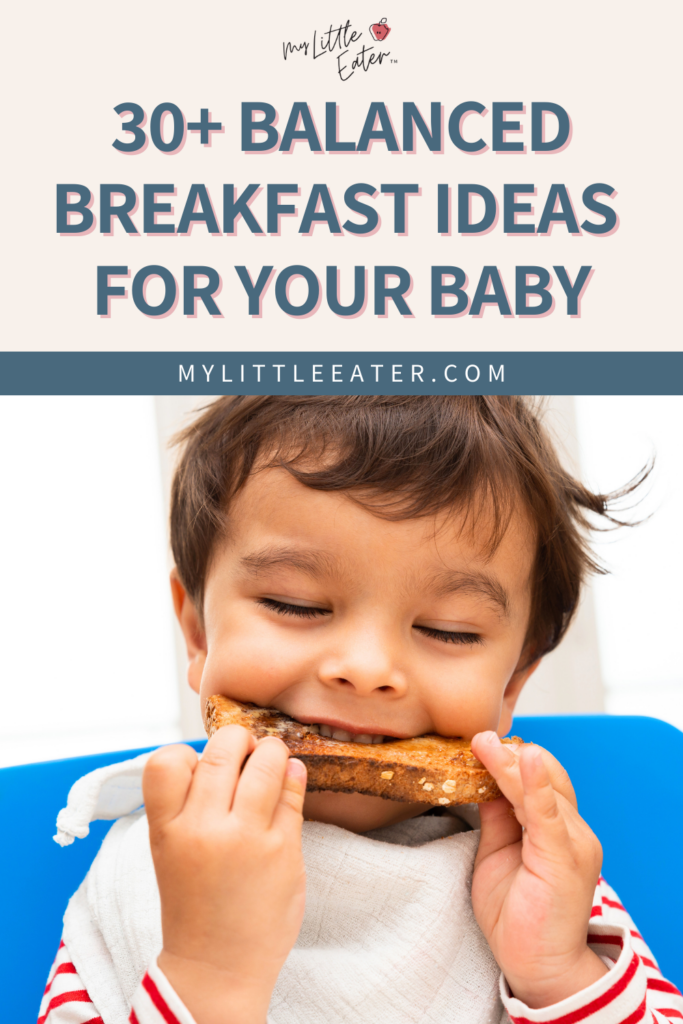
References
- Godos, J., Scazzina, F., Paternò Castello, C., Giampieri, F., Quiles, J. L., Briones Urbano, M., Battino, M., Galvano, F., Iacoviello, L., de Gaetano, G., Bonaccio, M., & Grosso, G. (2024). Underrated aspects of a true Mediterranean diet: understanding traditional features for worldwide application of a “Planeterranean” diet. Journal of translational medicine, 22(1), 294. https://doi.org/10.1186/s12967-024-05095-w
- Cook, J., & Reddy, M. (2001). Effect of ascorbic acid intake on nonheme-iron absorption from a complete diet. The American journal of clinical nutrition. 73. 93-8. DOI: 10.1093/ajcn/73.1.93.)
- Deshmukh-Taskar, P. R., Nicklas, T. A., O’Neil, C. E., Keast, D. R., Radcliffe, J. D., & Cho, S. (2010). The relationship of breakfast skipping and type of breakfast consumption with nutrient intake and weight status in children and adolescents: the National Health and Nutrition Examination Survey 1999-2006. Journal of the American Dietetic Association, 110(6), 869–878. https://doi.org/10.1016/j.jada.2010.03.023
- Gibson S. (2003). Micronutrient intakes, micronutrient status and lipid profiles among young people consuming different amounts of breakfast cereals: further analysis of data from the National Diet and Nutrition Survey of Young People aged 4 to 18 years. Public health nutrition, 6(8), 815–820. https://doi.org/10.1079/phn2003493
- Wang, K., Niu, Y., Lu, Z., Duo, B., Effah, C. Y., & Guan, L. (2023). The effect of breakfast on childhood obesity: a systematic review and meta-analysis. Frontiers in nutrition, 10, 1222536. https://doi.org/10.3389/fnut.2023.1222536
- Hoyland, A., Dye, L., & Lawton, C. L. (2009). A systematic review of the effect of breakfast on the cognitive performance of children and adolescents. Nutrition research reviews, 22(2), 220–243. https://doi.org/10.1017/S0954422409990175
- Government of Canada. (2024). Nutrition for Healthy Term Infants: Recommendations from Six to 24 Months. Retrieved from https://www.canada.ca/en/health-canada/services/canada-food-guide/resources/nutrition-healthy-term-infants/nutrition-healthy-term-infants-recommendations-birth-six-months/6-24-months.html
- Vos, M. B., Kaar, J. L., Welsh, J. A., Van Horn, L. V., Feig, D. I., Anderson, C. A. M., Patel, M. J., Cruz Munos, J., Krebs, N. F., Xanthakos, S. A., Johnson, R. K., & American Heart Association Nutrition Committee of the Council on Lifestyle and Cardiometabolic Health; Council on Clinical Cardiology; Council on Cardiovascular Disease in the Young; Council on Cardiovascular and Stroke Nursing; Council on Epidemiology and Prevention; Council on Functional Genomics and Translational Biology; and Council on Hypertension (2017). Added Sugars and Cardiovascular Disease Risk in Children: A Scientific Statement From the American Heart Association. Circulation, 135(19), e1017–e1034. https://doi.org/10.1161/CIR.0000000000000439
- World Health Organization. (2015). Guideline: sugars intake for adults and children. Retrieved from https://www.who.int/publications/i/item/9789241549028
- Fidler Mis, N., Braegger, C., Bronsky, J., Campoy, C., Domellöf, M., Embleton, N. D., Hojsak, I., Hulst, J., Indrio, F., Lapillonne, A., Mihatsch, W., Molgaard, C., Vora, R., Fewtrell, M., & ESPGHAN Committee on Nutrition: (2017). Sugar in Infants, Children and Adolescents: A Position Paper of the European Society for Paediatric Gastroenterology, Hepatology and Nutrition Committee on Nutrition. Journal of pediatric gastroenterology and nutrition, 65(6), 681–696. https://doi.org/10.1097/MPG.0000000000001733
- Centers for Disease Control and Prevention. (2023). Food & Drinks for 6 to 24 months old. Food and Drinks to Avoid or Limit. Retrieved from https://www.cdc.gov/nutrition/infantandtoddlernutrition/foods-and-drinks/foods-and-drinks-to-limit.html
- Spill, M. K., Johns, K., Callahan, E. H., Shapiro, M. J., Wong, Y. P., Benjamin-Neelon, S. E., Birch, L., Black, M. M., Cook, J. T., Faith, M. S., Mennella, J. A., & Casavale, K. O. (2019). Repeated exposure to food and food acceptability in infants and toddlers: a systematic review. The American journal of clinical nutrition, 109(Suppl_7), 978S–989S. https://doi.org/10.1093/ajcn/nqy308
- Government of Canada. (2014). Infant Nutrition. https://www.canada.ca/en/health-canada/services/infant-care/infant-nutrition.html
- Unger, S. L., Fenton, T. R., Jetty, R., Critch, J. N., & O’connor, D. L. (2019). Iron requirements in the first 2 years of life. Paediatrics & child health, 24(8), 555–556. https://doi.org/10.1093/pch/pxz148
- Holt, K., Wooldridge, N.H., Story, M., & Sofka, D. (2011). Bright Futures Nutrition. American Academy of Pediatrics. https://doi.org/10.1542/9781581106244
- Butte, N., Cobb, K., Dwyer, J., Graney, L., Heird, W., Rickard, K., American Dietetic Association, & Gerber Products Company (2004). The Start Healthy Feeding Guidelines for Infants and Toddlers. Journal of the American Dietetic Association, 104(3), 442–454. https://doi.org/10.1016/j.jada.2004.01.027
- Barceló-Coblijn, G., & Murphy, E. J. (2009). Alpha-linolenic acid and its conversion to longer chain n-3 fatty acids: benefits for human health and a role in maintaining tissue n-3 fatty acid levels. Progress in lipid research, 48(6), 355–374. https://doi.org/10.1016/j.plipres.2009.07.002
- National Institutes of Health. (2023). Omega-3 Fatty Acids Fact Sheet for Health Professionals. https://ods.od.nih.gov/factsheets/Omega3FattyAcids-HealthProfessional/#en2
- Robertson, T. M., Alzaabi, A. Z., Robertson, M. D., & Fielding, B. A. (2018). Starchy Carbohydrates in a Healthy Diet: The Role of the Humble Potato. Nutrients, 10(11), 1764. https://doi.org/10.3390/nu10111764
- Prasadi V.P., N., & Joye, I. J. (2020). Dietary Fibre from Whole Grains and Their Benefits on Metabolic Health. Nutrients, 12(10), 3045. https://doi.org/10.3390/nu12103045
- Knai, C., Pomerleau, J., Lock, K., & McKee, M. (2006). Getting children to eat more fruit and vegetables: a systematic review. Preventive medicine, 42(2), 85–95. https://doi.org/10.1016/j.ypmed.2005.11.012
- Cook, J., & Reddy, M. (2001). Effect of ascorbic acid intake on nonheme-iron absorption from a complete diet. The American journal of clinical nutrition. 73. 93-8. DOI: 10.1093/ajcn/73.1.93.
- Mennella J. A. (2014). Ontogeny of taste preferences: basic biology and implications for health. The American journal of clinical nutrition, 99(3), 704S–11S. https://doi.org/10.3945/ajcn.113.067694
- Trabulsi, J. C., & Mennella, J. A. (2012). Diet, sensitive periods in flavour learning, and growth. International review of psychiatry (Abingdon, England), 24(3), 219–230. https://doi.org/10.3109/09540261.2012.675573
- Fox, M. K., Pac, S., Devaney, B., & Jankowski, L. (2004). Feeding infants and toddlers study: What foods are infants and toddlers eating?. Journal of the American Dietetic Association, 104(1 Suppl 1), s22–s30. https://doi.org/10.1016/j.jada.2003.10.026
- Ramsay, S. A., Branen, L. J., Fletcher, J., Price, E., Johnson, S. L., & Sigman-Grant, M. (2010). “Are you done?” Child care providers’ verbal communication at mealtimes that reinforce or hinder children’s internal cues of hunger and satiation. Journal of nutrition education and behavior, 42(4), 265–270. https://doi.org/10.1016/j.jneb.2009.07.002
- Harris, G., & Mason, S. (2017). Are There Sensitive Periods for Food Acceptance in Infancy?. Current nutrition reports, 6(2), 190–196. https://doi.org/10.1007/s13668-017-0203-0
- Vale, S. L., Lobb, M., Netting, M. J., Murray, K., Clifford, R., Campbell, D. E., & Salter, S. M. (2021). A systematic review of infant feeding food allergy prevention guidelines – can we AGREE?. The World Allergy Organization journal, 14(6), 100550. https://doi.org/10.1016/j.waojou.2021.100550
- Kakieu Djossi, S., Khedr, A., Neupane, B., Proskuriakova, E., Jada, K., & Mostafa, J. A. (2022). Food Allergy Prevention: Early Versus Late Introduction of Food Allergens in Children. Cureus, 14(1), e21046. https://doi.org/10.7759/cureus.21046
- American College of Allergy, Asthma & Immunology. (2023). Food Allergy. https://acaai.org/allergies/allergic-conditions/food/
- Egg, S., Erler, J., Perktold, B., Hasenegger, V., Rust, P., Ramoner, R., König, J., & Purtscher, A. E. (2019). Traditional v. modern dietary patterns among a population in western Austria: associations with body composition and nutrient profile. Public health nutrition, 22(3), 455–465. https://doi.org/10.1017/S1368980018003270

Bianca Gruenewald, RD
Bianca is a Registered Dietitian and works in a client support role at My Little Eater Inc. She's a proud auntie to her three year old niece and four year old nephew!

Bianca Gruenewald, RD
Bianca is a Registered Dietitian and works in a client support role at My Little Eater Inc. She's a proud auntie to her three year old niece and four year old nephew!
